GREEN LIVING

Paradise Preserved Avani+ Fares Maldives Resort Encourages Eco-Tourism
Sip and Savor Sustainably in Temecula
Exploring Central Indiana's Midwestern Charm



Paradise Preserved Avani+ Fares Maldives Resort Encourages Eco-Tourism
Sip and Savor Sustainably in Temecula
Exploring Central Indiana's Midwestern Charm


There’s a new service in the Phoenix Valley that makes it easier than ever to keep food out of the landfill. Mill is a food recycler that takes all your food scraps and leftovers — even things like bones and avocado pits — and dries and grinds them into nutrient-rich grounds. Mill works automatically while you sleep, is completely odorless, and only needs to be emptied about once a month, meaning it’s cleaner and easier than typical composting. Then, Phoenix’s own R.City collects your grounds right from your doorstep monthly, turns them into compost, and uses them to grow more food for the community.
Service costs just $35/month. Visit mill.com/greenliving for a free 30-day trial.


“The Mill and R.City service has changed composting from being a stinky and annoying chore to a simple process even our kids can do. It has also revolutionized the way our family thinks about where our food waste goes, what is sent to landfill and how we can do better for the planet. Our weekly trash pick up has also halved in size and doesn’t get smelly in the Arizona heat anymore!”
Renee Mesa, AZ


“I’ve always been intimidated by the amount of work to compost on my own. With Mill and R.City, I’m grateful to have a solution that is user-friendly and does the work for me. Composting has never been so easy! I’m at ease knowing my food scraps will help the local community and farmers.”
Jyll Tempe, AZ
“There are many things I love about the Mill! I love how well it reduces food waste. I had a huge package of bok choy that I was a bit worried it couldn’t manage, but it brought it down to a fraction beautifully! I love the design; it makes food recycling modern and sexy! The app is great to use too; it connects like other home smart devices, and it’s easy to find out if something you have can be recycled with the Mill.
I love this device!”
Alen Mesa, AZ



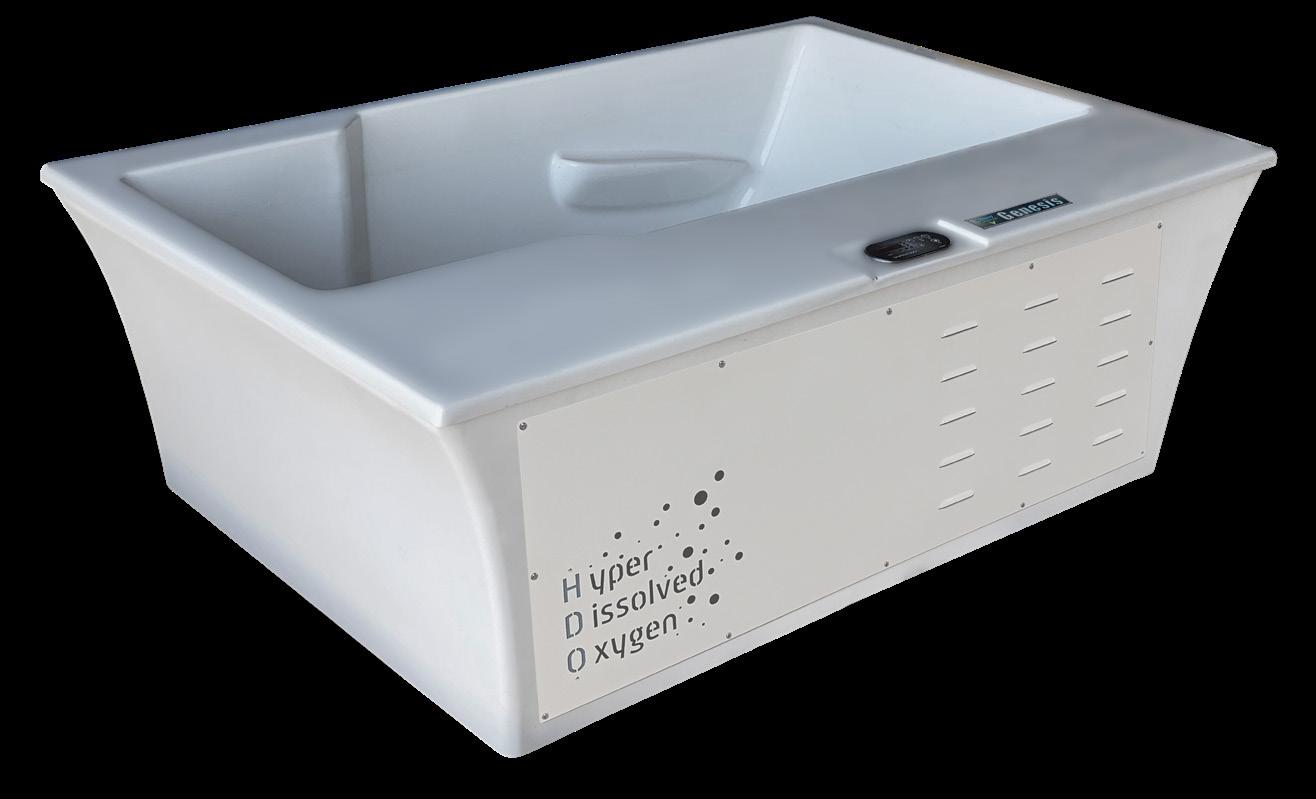


Embarking on adventures, whether near or far, leaves a unique imprint on each traveler's soul. After the exhilaration of exploration, nurturing your body becomes an intimate ritual. Pneuma Industries' Genesis series soaking tubs beckon, promising a tailored oasis to replenish weary voyagers like yourself.
Picture yourself sinking into the embrace of our Genesis tubs, where every pore of your being is enveloped in rejuvenating oxygen-rich waters. This isn't just a soak; it's a personalized sanctuary crafted to elevate your post-travel experience. In as little as 25 to 60 minutes per day you can receive restorative benefits that include revitalization of tired muscles and a rejuvenation of spirit.
With intuitive controls at your fingertips, choose the perfect ambience for your personal retreat. Will you indulge in the warm embrace of temperatures up to 104°F or invigorate your senses with a customizable cold plunge, ranging from 38°F to 104°F degrees The choice is yours, tailored to suit your unique preferences.
As a traveler, you understand the importance of renourishing your body with quality water, infused with essential minerals. Let the water's gentle embrace
By Michael Geyertransport you, while oxygen amplifies its restorative power, nurturing your body from within. This synergy, this dance between body and environment, unfolds a personalized journey of wellness, leaving you refreshed and revitalized after your travels.
Your well-being is our priority, and that's why we've designed the Genesis series soaking tubs to cater to your every need. Enhanced with oversized filtration systems and medical-grade oxygen concentrators, each soak becomes a bespoke experience, curated just for you. It's not just about rejuvenation; it's about reconnecting with yourself, finding solace in the healing embrace of water, oxygen, and minerals.
Pneuma Industries invites you to embark on a deeply personal journey to post-travel bliss. Let our Genesis series soaking tubs be your sanctuary, where the world fades away, and all that matters is your well-being. Embrace this intimate fusion of luxury and wellness, and rediscover the joy of travel, one rejuvenating soak at a time.
For further details, please visit pneumaindustries.com or reach out to us at (480) 714-2281. Your personalized oasis awaits.


tequila isn’t just more
friendly, it also tastes better
Mediterranean Salad + Wildflower’s Roasted Veggie Egg Sandwich
A music industry photographer releases a captivating collection of photos that studies the interconnectedness of all living things
Could Phoenix Redefine Public Transportation? Examining our city’s car culture
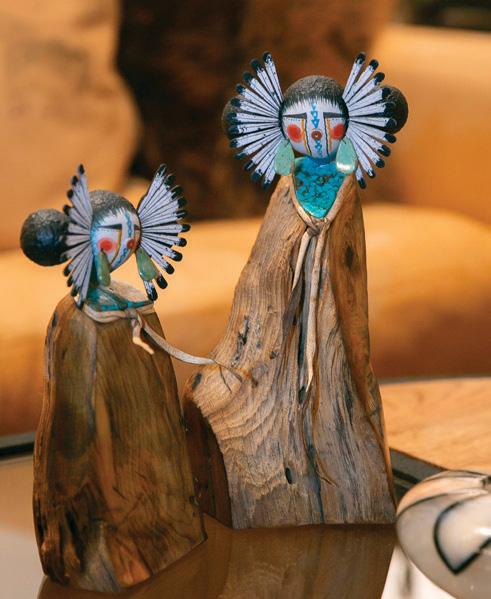


WORLDWIDE SHIPPING MADE IN THE USA

SPECIALIZING IN CUSTOM ORDERS
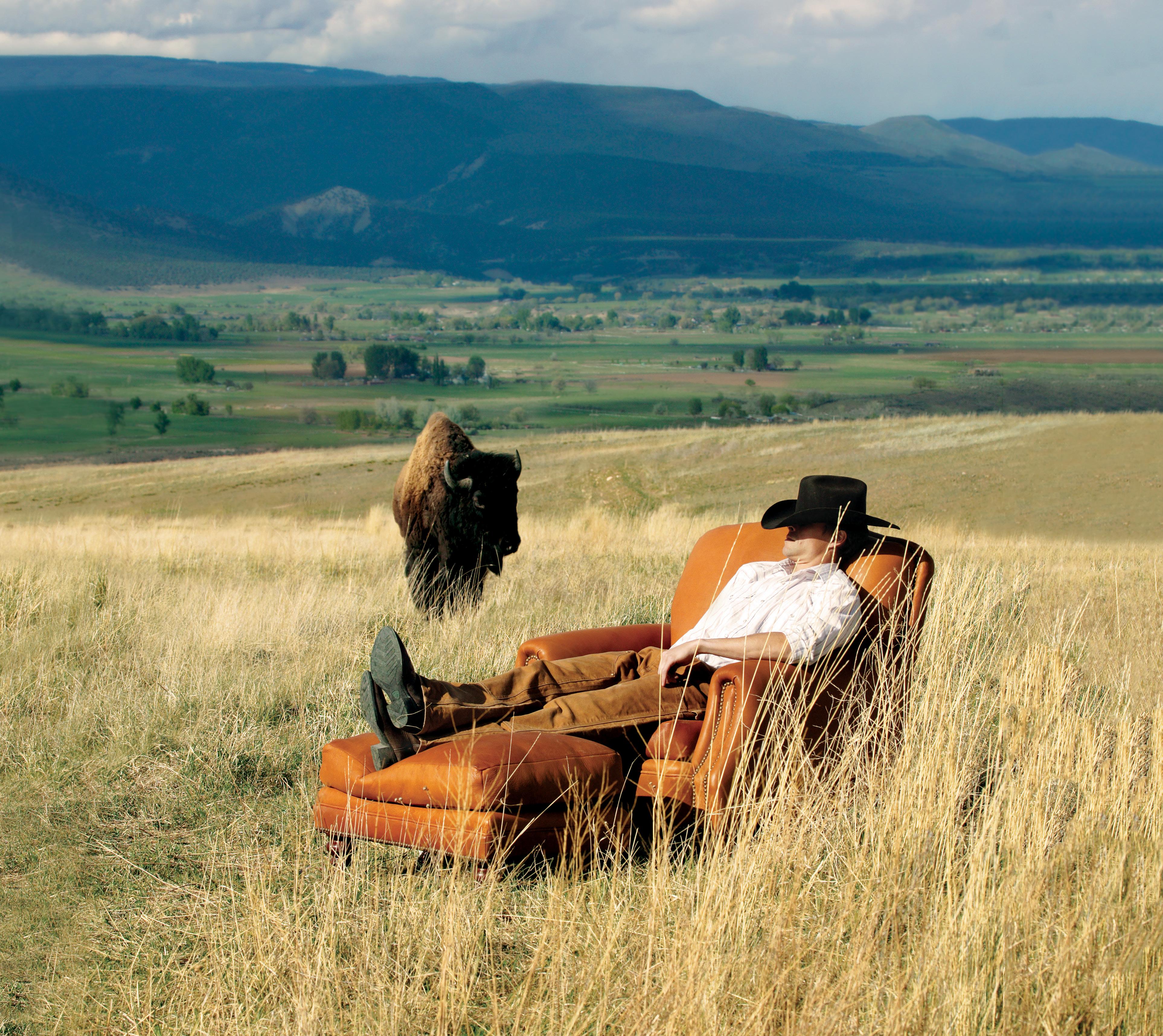
Did you know that most mass-produced furniture contains harmful chemicals that can slowly make their way into your home exposing your family and pets to low-level long-term exposure?
Our luxurious, heirloom quality buffalo leather furniture is handmade in America by skilled craftsmen using renewable materials and responsible tanning methods. Each piece is fully customizable, built to last, extremely durable, and made with clean, wholesome goodness. Just pure, simple furniture.

Dear Readers,
Travel is powerful. It introduces us to parts unknown, allowing for learning and exploration. What’s most powerful about travel is that when we explore new, mysterious places either at home or abroad, we often learn about ourselves in the process. Through the lens of travel, we often discover things about ourselves that perhaps we didn’t know before — or delve more deeply into aspects of ourselves that we’d like to know more about.
With travel comes a natural curiosity. For me, nurturing that curiosity can be exceptionally special. Exploring the feelings of excitement, fear, confusion, joy, and sometimes frustration that often come with traveling and interacting with other communities and cultures can be the best way to get to know myself. The act of travel provides a sense of fulfillment and personal expansion that is difficult to replicate while immersed in the same environment day in and day out. It imparts growth in ways that the best coach or therapist can’t teach and a sense of rejuvenation that the even most exclusive spa weekend can’t provide.
As you make your travel plans this summer, remember to keep your footprints light. When possible, wear reef-safe sunscreen! Embrace slow travel, electric vehicles, biking, walking and be mindful of your impact on the community that welcomes you in. Chat up a local, contribute to the local economy and in general, try to leave your destination a little better than when you arrived.
Most importantly, remember that travel is, in many ways, food for the soul. As you make your travel plans this summer, may your hunger be satiated and your plate always full.
Thanks for reading,
Shelby Tuttle Managing Editor

Ellen Haines, writer
Ellen Haines is a licensed hypnotherapist specializing in Rapid Transformational Therapy (RTT). Through hypnosis, she helps clients access their subconscious, uncovering insights and transforming unhelpful behavior patterns. Her practice addresses issues like trauma, outdated belief systems, and emotional blocks, aiming for holistic healing and lasting change. Ellen's areas of expertise include anxiety, depression, chronic disease, and narcissistic abuse. For more information, visit www.ellenhaines.com.
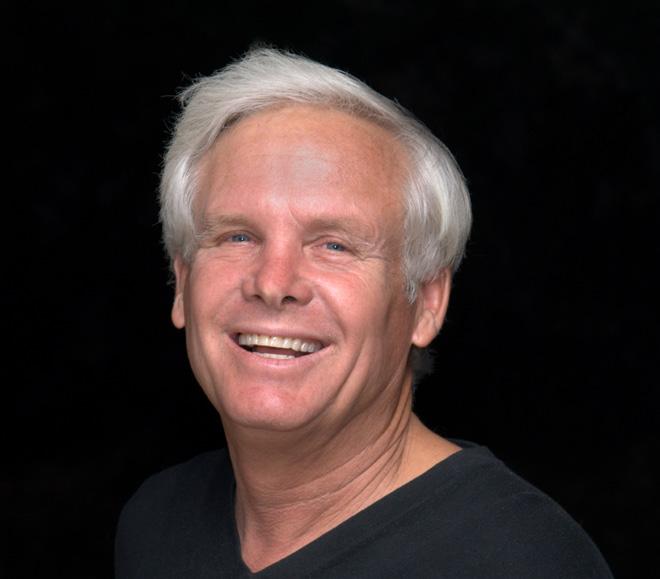
David M. Brown, writer
Born, raised, and educated in Philadelphia, Pa., David M. Brown is a Valley-based freelancer. In addition to sustainability, he writes about the arts, architecture, cars, and other topics he is passionate about. Learn more about him at www.azwriter.com.
PUBLISHER
MANAGING EDITOR
ONLINE EDITOR
ART DIRECTION & DESIGN
COPY EDITOR
STAFF PHOTOGRAPHER
CONTRIBUTORS
Madeleine Bell
David M. Brown
Jennifer Burkhart
John Burkhart
Alison Bailin Batz
Anna Dorl
Melat Alebachew
Yula Armstrong
Paige Sundelius
ADVERTISING SALES
Pat Ford - pat.f@greenlivingmag.com
Dorie Morales
Shelby Tuttle
Shelby Tuttle
Sly Panda Design
Erin Wilson
Brett Prince
Katelyn Dyer
Angela Fairhurst
Ellen Haines
Misty Milioto
Rita Mouchi
Jennifer Kaiser - jennifer.k@greenlivingmag.com
Dorie Morales - sales@greenlivingmag.com
CONTACT US AT:
Subscriptions: hello@greenlivingmag.com
Advertising: sales@greenlivingmag.com
Editorial: editor@greenlivingmag.com
480.840.1589 • www.greenlivingmag.com 13845 N Scottsdale Rd, Ste. 201, Scottsdale, AZ 85254


Please recycle this magazine


Last month, the Arizona Science Center welcomed young science fair winners from across the state for the Arizona Science and Engineering Fair at Sun Devil Stadium. The event brought together first-place Arizona science fair winners to compete for thousands of dollars in prizes and scholarships.

Bridge of Weir, a supplier of fine automotive leather to the world’s most-respected luxury car brands like Aston Martin, McLaren, Jaguar Land Rover and Polestar, recently launched two revolutionary tanning technologies, BioTAN and FreeTAN, marking significant step forward in the development of next-generation, bio-based and biodegradable leather.
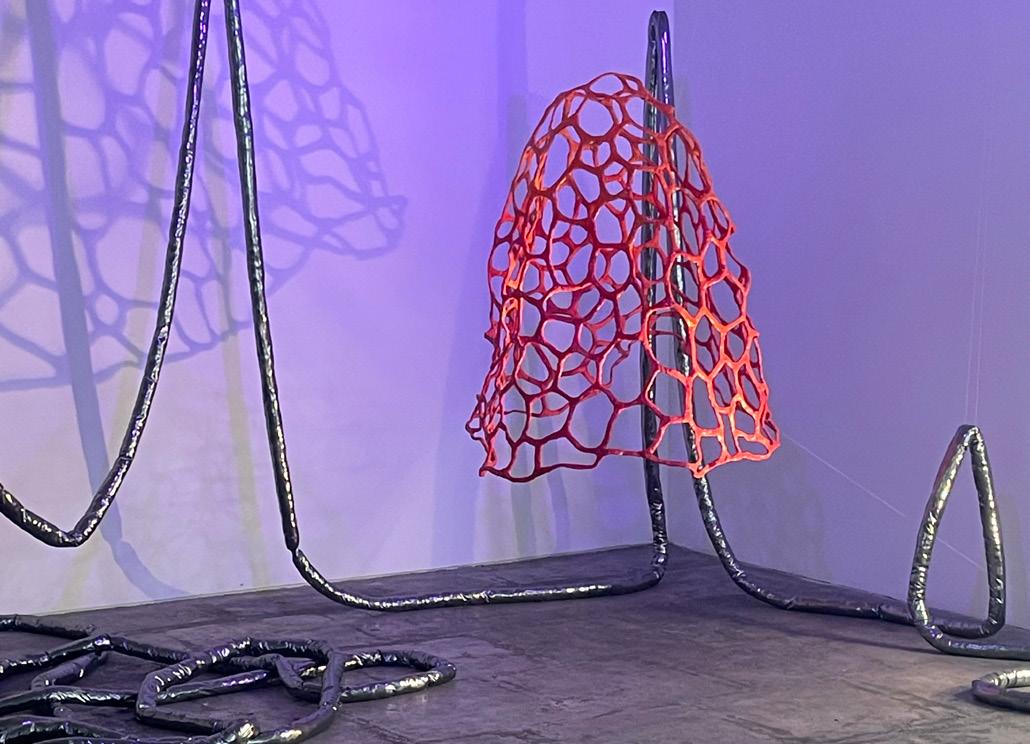
Last month, Green Living attended the Form. Space. Vision. event at de Sarthe gallery. Curated by Cece Cole, the show examined our global climate future through the lens of the artist. Sculpture by Krista Leigh Davis.

Two Florida Girl Scouts developed a blue spirulina coral-shaped cookie topped with salted caramel to bring awareness to the need to save the planet’s coral reefs. The girls presented the cookies before the leadership team at Girl Scouts of Tropical Florida and hope to see it adopted by the Girl Scouts in the future.

Jon and Leatrice Kitchell, owners of Venue Projects, recently shared with us their passion for growing their own produce, creating home cooked meals, and inspiring others to do so, as well!



On April 9, the U.S. Court of Appeals rejected challenges that sought to overturn California’s authority to set its own protective standards for pollution from new cars and trucks under the Clean Air Act. “California’s clean car standards will save lives, protect people from the climate crisis and unhealthy air pollution, save drivers money, and help create good new jobs,” said Alice Henderson, director and lead counsel for Environmental Defense Fund,

New Mexico’s ecosystems and drinking water sources are already endangered. However according to a new analysis recently released by American Rivers, new threats to the state’s rivers also pose a risk to groundwater resources. The state’s rivers now collectively rank as the most endangered in America.
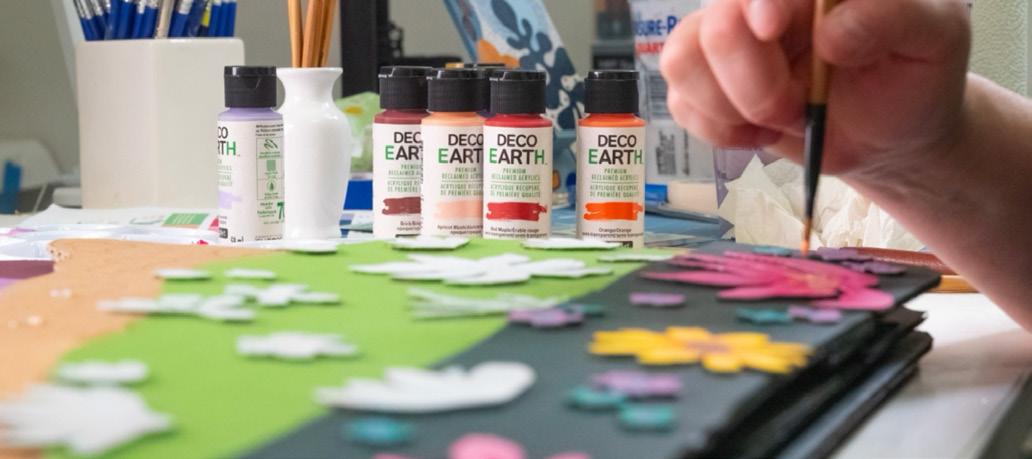
DecoArt, a manufacturer of acrylic craft paints, recently announced its introduction of a new DecoEarth line. DecoEarth is an all-purpose acrylic paint made with 70% recycled material and the first of its kind on the market. Twenty seven matte-finish colors will soon be available in national retail stores.

Environmentalist and climate music artist Inanna released her latest single "Contagious” on Earth Day. "Contagious" emphasizes the transformative power of positive contagion. With evocative lyrics, Inanna urges listeners to embrace the collective responsibility of nurturing our planet.

On April 4, Vice President Kamala Harris and EPA Administrator Michael Regan announced a $6.97 billion investment from the National Clean Investment Fund (NCIF) to Climate United, a national nonprofit focused on delivering the benefits of green technologies to communities across the county.



habitatcaz.org/cars

Nearly everything we do and product we consume can have an impact on the environment and travel is no exception. Making a few careful considerations when packing for a short road trip or a months-long adventure can be the difference between reducing or increasing your eco-footprint on on the planet. Simply making a few careful decisions about what goes in your suitcase — or even what it’s made of —can be the difference between protecting the planet and polluting it. Here are some unique brands to consider when embarking on your travels this summer.
Certified B-Corporation UpCircle has been celebrated for its sustainable skincare products, including the company’s natural cleansing bars. Whether you’re packing a special soap, shampoo, or conditioner bar (or all of the above) on your next adventure, UpCircle’s Soap Travel Tin can come in handy. The product includes a drainage tray that allows water to fall through its small holes as your soap bar dries out after it leaves your shower or sink. The tin is constructed from aluminum “to stay rust-free,” making it fully free from plastic – it even comes in a cardboard box. This item is a must-have if you’re tired of soapy water splashing onto your souvenirs. www.us.upcirclebeauty.com
These packing cubes were created to fit perfectly inside of Paravel carry-on luggage, but their versatility allows buyers to use them for travel, home, and even work. Paravel’s Packing Cube Quad is four differently sized cubes (one large, one medium, and two small). A pack of four cubes is available in seven colors, and they are also customizable with space for a monogram or three letters. The packing cubes themselves are created from “[Paravel’s] lightweight, water-resistant Negative Nylon®… made from 16 recycled plastic bottles.” In a world where you can buy essentially any packing cubes, why not purchase a type that utilizes recycled materials, instead of adding more waste to a landfill? www.tourparavel.com
Toiletry bags and duffle bags can be expensive to buy separately, especially if you’re trying to purchase quality products that don’t leave a negative dent in our planet. Terra Thread really lives up to its name, as an Earth-centered company that sells an array of consciously created bags and beanies. This Sustainable Travel Set includes Terra Thread’s Toiletry and Duffle bags. Both pieces are created from certified Fair Trade organic cotton in a Fair Trade Certified™ factory with lead-free metal features. The dynamic bag duo is additionally GOTS (Global Organic Textile Standard) Certified, as are all of Terra Thread’s portable pieces. www.terrathread.com






When it’s time to go on a trip, many of us run to the nearest travel section of whatever store we’re in and pick up a couple of cheap, TSA-approved mini bottles. What if there were a better option than continually buying massproduced plastic? The Original Essential Travel Bottle from Ries might be the solution that you’re seeking. This 3.4-ounce container, made from medical-grade PCR (a recycled plastic resin), is the perfect size for airplane travel. Its patented airless pump allows users to access their beauty products within, like a favorite face lotion or your #1 shampoo. Whatever you might keep inside, for travel and/or day-to-day living, reuse The Original Essential Travel Bottle until it’s ready to be recycled. www.ries-ries.com
For the eco-conscious traveler, a water filter bottle is an essential that not only helps you kick the single-use plastic bottle habit but also filters out 99.9999% of bacteria, viruses, heavy metals, chemicals, and other nasty things lurking in your water. If you’re traveling to a third-world country or even filling up from a river or stream when hiking or camping, this water bottle will definitely come in clutch, keeping you safe and hydrated on your outdoor adventures. www.lifestraw.com

FFor nearly a decade, White Tank Mountains Conservancy (WTMC) has stood as a bastion of conservation during a time of rapid urbanization in the region they stand to protect. With each passing year, WTMC has upheld its mission to preserve the natural beauty of the White Tank Mountains for future generations and is proud to announce its active role in conceptualizing a new wildlife linkage between the White Tank and Belmont Mountain ranges in Buckeye, Arizona.
This visionary initiative aims to ensure sustained connectivity for the region's precious wildlife. This is a first-of-its-kind collaboration between developers, government agencies, municipalities, and other stakeholders in the state of Arizona.
For those who do not know, a wildlife corridor is a strip of habitat that connects two or more larger areas
of similar habitat, allowing for the free movement of wildlife between them. These corridors serve as vital pathways for animals to migrate, disperse, and access resources such as food, water, mates, and shelter. They are essential for maintaining genetic diversity within populations and ensuring the long-term survival of many species by facilitating their ability to adapt to changing environmental conditions. Wildlife corridors
can be natural, such as rivers, mountain ranges, or forests, or they can be humanmade, such as overpasses, underpasses, or designated wildlife crossings.
“White Tank Mountains Conservancy is dedicated to and focused on working together with private sector and government partners to conceptualize what this beautiful area will look like in 10, 20, and 50 years,” says Sharma Torrens, Executive Director of White Tank Mountains Conservancy. “With collaboration, coordination, and innovation, we have developed a thoughtful linkage plan that will allow for sustainable development and the conservation of an important regional wildlife corridor for generations to come.”

As this project for future planning unfolded, WTMC was proud to receive the immediate support of Howard Hughes Holdings, the developer behind Teravalis, the 37,000-acre master planned community emerging along the Sun Valley Parkway in Buckeye.
“In the past, we have hit roadblocks in bringing the right people to the table to tackle wildlife and ecosystem issues in the face of development and urbanization,” says Torrens. “With their track record of responsible development of open spaces over the last six decades across the country, we are thankful for Howard Hughes' leadership in this conversation and to bring others into the fold.”
From a developer’s standpoint, Howard Hughes is stepping up to the plate to support WTMC’s conservation efforts by recognizing that sustainable development is more than brick and mortar — it is about fostering a community between the two mountain ranges.
“We're proud to collaborate with White Tank Mountains Conservancy as we envision,
plan, and develop Teravalis with respect to its natural environment," says David O’Reilly, Chief Executive Officer of Howard Hughes. "As a community builder, it is our responsibility to thoughtfully integrate the new community of Teravalis with its surroundings and create habitats where all walks of life can live, grow, and thrive.”
With a shared vision of blending built and natural environments, Teravalis, WTMC, and other stakeholders are forging pathways towards a community where both wildlife and humans coexist seamlessly.
To date, WTMC is working with Howard Hughes and Teravalis, LKY Development, BA Pacific, Pulte Homes, City of Buckeye, City of Surprise, Arizona State Land Department, Arizona Game and Fish Department, Maricopa County Flood Control District, Tartesso, Maricopa County Parks and Recreation Department, and the Bureau of Land Management on the linkage. Visit www.wtmconservancy.org/connectivity-initiative for more information and updates on the wildlife linkage project.

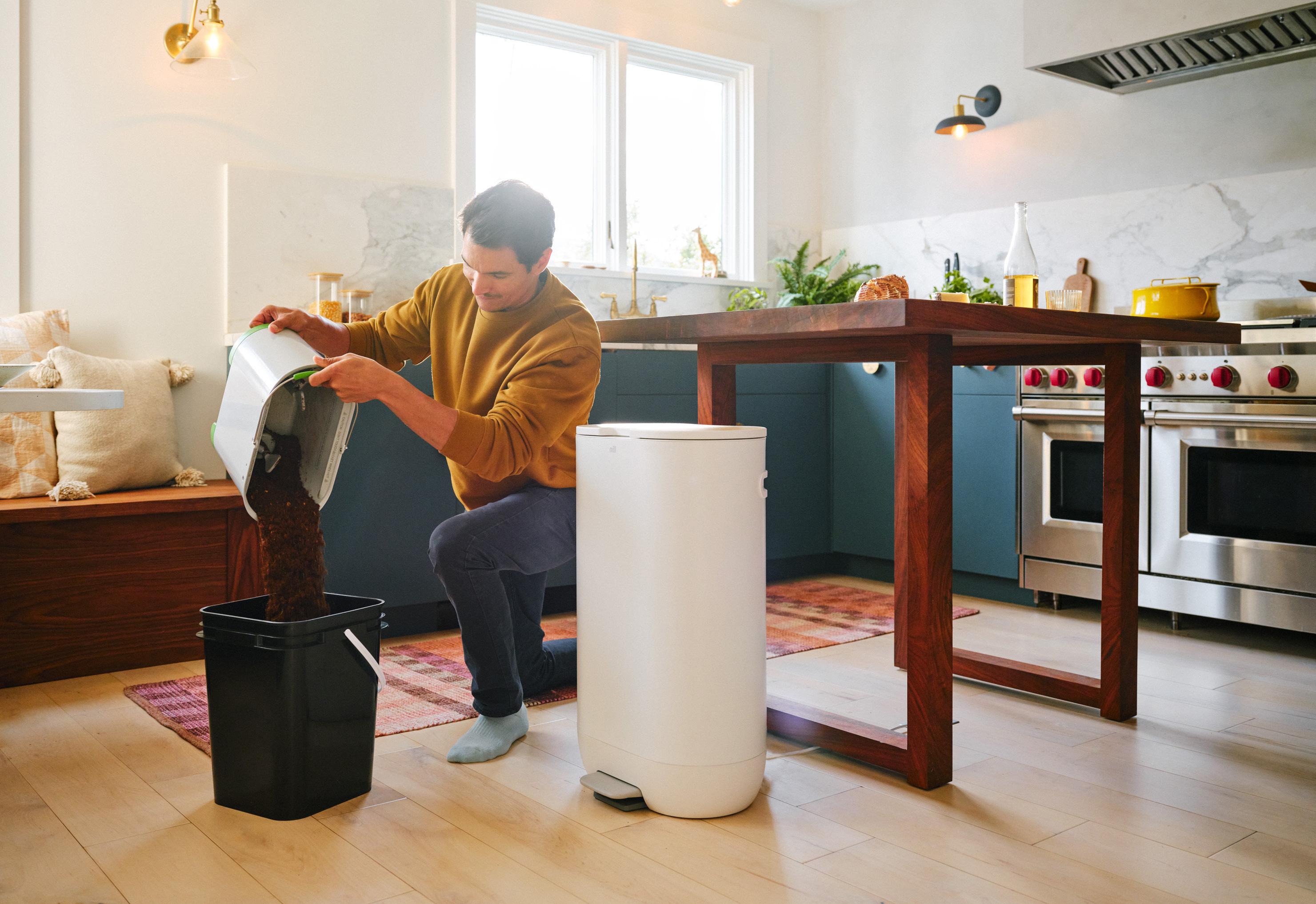
Mill Industries completes circle of organic recycling
TTrash your old way of thinking about green waste. A local partnership of technology and farming is creating the next revolution in food recycling. Mill Industries Inc., an in-home food-recycling company based in San Bruno, Calif., and R. City, J.D. Hill’s pioneering farm in South Phoenix, have developed a food wastereduction service for Phoenix residents.
Two early employees at Nest, Harry Tannenbaum and Matt Rogers, and a team of Apple and Google engineers, have built Mill, an odor-free, easy-to-use, and whisper-quiet recycling bin that prevents food waste at your home or in your office while supporting a strong local food system.
The bin takes all the food you can’t eat at home, and instead of wasting it or throwing it in the trash, Mill dries and grinds it into material that can be used as a resource on farms or in gardens. Because the food grounds are dehydrated, they get really small (food is 80% water) — so the bin takes weeks to fill up.
Once full, the R.City team picks up the grounds and takes them back to the farm where the grounds are used as part of an existing composting process to help grow marketable vegetables like squash, okra, kale, eggplant, cucumbers, carrots, and microgreens. Customers can receive these as part of an optional monthly Farm Box delivery to enjoy food facilitated by their recycling efforts.
“Leftover food isn’t waste,” says Tannenbaum, whose work with Rogers to create the Nest Learning Thermostat and other products inspired them to think innovatively about changing our perception of food waste and to make it easy for people to do the right thing. Their eco-mantra: Don’t toss your garbage into the garbage.
“When we started this business, I didn’t realize that food waste is the largest single component of our landfills,” he explains. “And I wouldn’t have thought it was households that were the largest producers of food waste. I thought grocery stores or restaurants or something like that.”
Today, Americans waste about 40% of the food they purchase without moving it forward to food banks, community pantries, and other facilities in need, he says. He adds that Arizona annually sends about 1.7 million tons of food to its landfills. That’s about 43 million tons each year nationwide.
A recent EPA report estimates that 58% of landfill methane emissions come from wasted food. When food rots in landfills, it produces methane gas that warms the planet faster than carbon dioxide.
600 pounds annually feeding the ravenous landfill. That totals about $1,900 each year per family wasted on unconsumed food, he says.
J.D. Hill, founder and president of R.City, the 16.5acre farm which is partnering with Mill, says, “When I set out to build R.City over ten years ago, my goal was to connect households with small local farms through a food waste collection service, and this new partnership with Mill makes it even easier for more people to get involved with almost no effort.”
Hill shares that he quickly responded to Mill’s proposal to join forces, understanding that he and his 20 employees would be closing the loop on the

“It makes no sense to be burning or burying our leftover food when it could be used as part of a composting process to grow more food on farms like J.D.’s,” he says.
Tannenbaum asks you to see the problem this way: Today, the average amount of food we waste is the same as buying five bags of groceries and leaving two in the parking lot. On average, that adds up to two pounds of food a day, 60 pounds monthly, and about
home/business-to-farm relationship. He recognized immediately that the service would have a positive environmental, economic, and social impact. Everyone would benefit from the opportunity.
Tannenbaum first thought about the challenge of food waste during COVID-19. Locked down in California, he confronted how much we waste.
“I thought about how much we waste and started talking to researchers, scientists, and soil experts about the challenges with our current waste system, in which food is thrown out into landfills with ripped

umbrellas, used car batteries, and squeezed-out toothpaste tubes,” he recalls.
“Reducing food waste is the number-one thing we can do in the next 30 years to have a positive impact on our planet, and the good news, it’s easy,” he adds. “We just need to stop throwing food in the trash — it’s a behavior change issue.”
Offering a free 30-day trial and pricing the pick-up service at just $35 per month thereafter, Mill delivers the convenient easyto-use bin to your home, office, or school. Once the bin is full, R.City picks up the residual grounds. In addition, customers receive unlimited odor filter refills, support, and free finished compost as many as four times a year.
The contemporarily designed bin is easy to use, with an aluminum bucket to collect the food grounds and a ceramic interior coating that helps the bin dehydrate food overnight.
“There is a foot pedal that opens it just like a trash can, it smells good, and the bin takes weeks to fill up,” says Hill, who is using it in his kitchen. “This means fewer pickups, a better kitchen experience, and an easy, practical way to prevent food waste while giving back to our local community.”
Expanding the circular business model will create opportunities for everyone.
Tannenbaum explains, “In less than a year, we’ve already helped people save one million pounds of food by turning kitchen scraps into food for farms and gardens,” he says. “We are fulfilling the promise of what technology and innovation can and should do for society, making people’s lives easier while also making a positive impact on the planet.”
For more information, visit www.mill.com.




AAccording to the World Health Organization, dementia affects 55 million people worldwide, with numbers projected to rise significantly in the coming years. Despite extensive research, there is currently no cure for this debilitating condition. However, emerging evidence suggests that lifestyle factors, such as cognitive stimulation, can play a significant role in improving overall brain health.
For caregivers, attending to their loved ones with dementia can present a profound challenge. Often faced with limited resources and a lack of effective solutions, caregivers can experience frustration when it comes to their ability to provide meaningful support. In light of this, a company called GeriGadgets is looking to provide hope for seniors living with dementia and other cognitive issues — and their caregivers — by offering innovative products that provide the needed stimulation and comfort the condition often requires.
Founded by Angela Fairhurst, Geri-Gadgets is more than a business; it’s a heartfelt endeavor driven by a profound desire to make a meaningful difference in the lives of others. Angela's journey with Geri-Gadgets began when her own mother was diagnosed with Lewy Body dementia. Witnessing her mother's daily struggles ignited her determination to seek innovative solutions that could provide comfort, stimulation, and joy to seniors like her mother, who often felt isolated and disconnected from their surroundings.
Angela embarked on a mission to create a therapeutic, sensorystimulating product tailored specifically for this vulnerable demographic. She endeavored not only to develop products that addressed the unique needs of seniors with dementia but to also help them experience a sense of engagement, empowerment, and dignity.
Geri Gadgets are simple and effective, providing safe and engaging activities suitable for all stages of cognitive decline, that also bring fun, joy, and quality of life to the daily grind of caregiving. Made of high-quality silicone, each “gadget” provides both mental stimulation and a means to occupy hands. Textured pieces, shape sorters and sensory buckets all provide versatile applications for users.

Fairhurst notes that the products are highly durable and built to withstand continuous use, making them more sustainable in comparison to cheaper alternatives that can quickly fall apart.
“They are meticulously crafted with the utmost care and attention to detail, meeting the highest standards of safety and effectiveness,” she says.
Geri Gadgets are also machine washable and easy to clean, an important factor in an item that is handled repeatedly.
“Caregivers can rest assured knowing that there’s no risk if someone puts the objects in their mouth,” says Fairhurst. “They’re nearly effortless to clean and maintain, which offers caregivers
a certain peace of mind.”
Geri-Gadgets boasts remarkable versatility. They allow loved ones to engage and bond with family members and leverage the therapeutic properties of silicone that promote cognitive stimulation, comfort, engagement, relaxation, improve focus and behaviors, and enhance overall well-being. Notably, the silicone buckets have redefined sensory engagement for individuals grappling with sensory deprivation, providing a secure and soothing outlet for tactile stimulation. The containers seamlessly integrate into the interactive experience.
As Geri-Gadgets continues to expand its reach, Fairhurst remains steadfast in her mission to provide comfort, joy, and empowerment to seniors and individuals facing sensory challenges. With an ever-growing portfolio of innovative products and a deep-seated commitment to making a difference, Geri-Gadgets is poised to lead the way in revolutionizing care for generations to come.
Visit www.geri-gadgets.com for more information.


IIn our quest for wellness, we meticulously scrutinize our diets, obsess over skincare ingredients, and purify our living spaces. Yet how often do we pause to consider the invisible pollutants clouding our minds?
Here’s a revelation: Toxic thoughts are the silent contaminants of our mental well-being, often overlooked yet profoundly impactful.
Years ago, my mind was a battleground of self-doubt and worry, sprinkled with a nasty fear of judgment. My thoughts ran wild, and I felt powerless to rein them in. This personal struggle led me to explore the depths of my mind, eventually guiding me toward a career in hypnotherapy. In my practice, I've witnessed the transformative power of detoxing our thoughts,
purifying our internal narratives, and cultivating a space within ourselves that radiates positivity.
If you find yourself caught in a relentless cycle of overthinking, self-comparison, or doubt, you’re not alone. Many of us grapple with a persistent inner critic. This voice amplifies fears and insecurities, leading you to question your decisions and worth. This inner critic can trigger defensiveness and irritability, fuel procrastination and a reluctance to embrace growth opportunities, and weave false
narratives about how others see us. When the voice inside your head creates all of this strain, it’s not just mentally draining; it's bad for your health.
Consider this: Every thought triggers a biochemical event in the brain, which creates a ripple effect within the entire body. Over time, certain pathways in the brain become more traveled, making negative thoughts feel almost automatic.
On a physical level, this floods our bodies with cortisol, the stress hormone. This means your thoughts aren’t just happening in your brain. Your thoughts are communicating with every cell of your being, creating physiological shifts in the body. If a cell has been exposed to a certain chemical consistently, it will adjust its chemical receptors to expect more of the same.
So, over time, if not addressed, our bodies begin to crave this state of stress. Stress becomes an addiction that leaves us feeling perpetually distracted, foggy, or like we're stuck in overdrive.
But here's the empowering part — we can change this. By intentionally focusing on different thoughts and emotions, we forge new pathways in our brains. To be clear, this isn't about ignoring our challenges and pretending everything's okay when it's not — that's not helpful. It's about honoring our feelings and choosing empowering thoughts to help us navigate the challenges we’re facing.
As a hypnotherapist, I've witnessed the remarkable transformations that occur when individuals shift their inner dialogue from being their own harshest critic to their biggest cheerleader. Such changes can have profound effects on both mental and physical health. I've seen mothers break free from the grips of postpartum depression, individuals find significant relief from chronic pain, and others overcome addictive behaviors. These examples highlight the power of positive self-talk and the deep impact it can have on overcoming personal challenges. The bottom line — there is vast potential for healing and growth within us all.
This Mental Health Awareness Month, why not start with a simple practice? Pay close attention to how you talk to yourself for one week. Whenever doubt or fear comes up, acknowledge it. Use daily life as an
opportunity to become curious about what’s driving your thoughts and feelings.
Neuroscience reveals that 90% of our thoughts, feelings, and behaviors are subconscious patterns learned from our experiences. Behavioral psychology, along with the biology of brain development, indicates that our subconscious programming is primarily established from birth to seven years old.
For example, a persistent fear of failure might stem from having a parent who was difficult to please. Similarly, difficulty letting go of control could trace back to a chaotic or dysfunctional childhood.
With this in mind, we can attempt to understand the core beliefs that are fueling any destructive, critical, or fearful thoughts. The subconscious mind, in its attempt to protect us, often clings to limiting beliefs such as "I'm not good enough," "I'm unworthy," or "I'm different." These beliefs, generalized from specific past experiences, significantly influence how we interpret and react to current situations.
As you begin to understand the deeper limiting beliefs sitting beneath your thoughts and feelings, you can begin to question their validity. Getting to the heart of the core beliefs holding you back is more effective than just trying to tweak your thoughts and emotions on the surface. Imagine the core belief as the root of a weed and your thought as the part of the weed you see above ground. To really make a change stick, you've got to yank it out by the root.
As you engage in this process, it's vital to practice self-compassion. Treat yourself with the same kindness, understanding, and support you would offer a good friend. When you notice self-critical thoughts or harsh judgments, remind yourself that everyone has flaws and makes mistakes, and it's okay to be imperfect.
The journey towards detoxing our minds is ongoing, demanding patience, practice, and sometimes, guidance. As we navigate this path, we get better and better at silencing the critic within. Slowly but surely, the uplifting and supportive voice grows louder and becomes stronger. As this unfolds, relationships improve, stress levels decrease, physical ailments vanish, and we find greater joy in the simple moments of life.

IIn a world where climate change looms as the greatest threat to human health, the Maldives stands as a frontline witness to its devastating impacts. With over 80% of its land area at risk of submergence from just a 1-meter rise in sea level, the urgency of sustainable development cannot be overstated. Escalating challenges such as soil erosion, beach loss, and saltwater intrusion into freshwater sources exacerbate the crisis.
Rising ocean temperatures further compound issues, leading to reduced tuna catches and more frequent extreme weather events, including storm surges, floods, and cyclones, directly impacting the wellbeing of the population. Acutely aware of the urgency, the Maldives is leading by example, implementing low-carbon growth strategies, sustainable and resilient smart healthcare services, and prioritizing environmental health in its development policies.
Nestled amidst the turquoise waters and pristine beaches of the Maldives, on the heart-shaped Baa Atoll formed by 105 coral reefs and 61 islands, in a UNESCO Biosphere Reserve site, lies Avani+ Fares, a beacon of sustainable luxury that balances environmental responsibility with practicality, coolness with kindness, design with function, and service with privacy.
Avani+ Fares Maldives Resort demonstrates a robust commitment to ESG (Environmental, Social, and Governance) initiatives, particularly emphasizing its
"4R" principle (Reduce, Reuse, Recycle, and Replace) to minimize its environmental impact. This commitment is exemplified through several specific initiatives.
The resort's adoption of solar photovoltaic (PV) technology as an alternative energy source signifies a proactive step towards reducing its carbon footprint and reliance on traditional fossil fuels. By implementing food composting practices, the resort contributes to waste reduction and environmental sustainability by diverting organic waste from landfills and turning it into valuable compost. Additionally, the resort's sewage treatment and recycling systems demonstrate a commitment to responsible water management. Treating sewage for reuse as irrigation water not only conserves water resources but also minimizes the environmental impact of wastewater disposal. Finally, the use of heat exchangers on generators for central hot water heating is a resourceefficient approach that harnesses waste heat, enhancing energy efficiency and reducing energy consumption.
These initiatives align with the resort's dedication to environmental responsibility and its broader goal of reducing its environmental footprint. Moreover,
its ambitious target of a 75% reduction in singleuse plastic by 2024 underscores its commitment to addressing plastic pollution and promoting sustainable alternatives. Additionally, the resort's collaboration with conservation agencies to protect marine life and habitats showcases a proactive approach to environmental stewardship, contributing to the broader well-being of the Maldivian ecosystem.
As I set foot on this seemingly untouched idyllic island of white sandy beaches and vibrant biodiversity, I am immediately struck by its commitment to ecological preservation and community engagement, echoing the Maldives' strategic approach to combat climate change and foster low-carbon growth.
Since its inception in May 2023, Avani+ Fares has epitomized this urgency by integrating innovative initiatives to combat climate change into its very core. At the heart of Avani+ Fares’ ethos lies a commitment to environmental stewardship. From energy-efficient design to sustainable sourcing of materials, every aspect of the resort is meticulously crafted to minimize its carbon footprint. A tropic-proof rooftop solar system is installed on the back of house buildings, harnessing the abundant tropical sunshine to power the resort's operations sustainably. Even the lush landscaping is curated to promote biodiversity, with native plants thriving in carefully preserved ecosystems. Gray water is saved and used to irrigate the plants.
The food and drink of the four restaurants and two bars at the resort are inspired by the Maldivian wana mola , a traditional grinding stone and rolling pin used to blend fresh spices and leaves into pastes for marinades, grilling, and curries. In each restaurant, organic, locally, and sustainably sourced ingredients make up the fare which includes creative feasts from chefs around the world. Fresh coconuts from the ancient plantation and seafood from the crystal blue waters are part of the delights. Nothing goes to waste. Even the orange peels are used, candied by dipping them in 72% dark chocolate and presented to guests as a zero-waste, guilt-free welcome treat placed in a glass jar in their rooms ahead of their arrival.
Notably, there is no use of plastic on the island. Reusable glass water bottles and other eco-friendly amenities such as refillable toiletry dispensers and compostable toothbrushes and shower caps are provided.
Avani+ Fares’ dedication to sustainability extends to its gift shop, Island Bazaar, where guests can find a curated selection of Maldivian fashion, jewelry, and homeware brands offering guests authentic, handcrafted souvenirs, designed by a collective of local artisans and designers.
By featuring products made by local artisans and businesses, the resort supports the regional economy and reduces the carbon footprint associated with
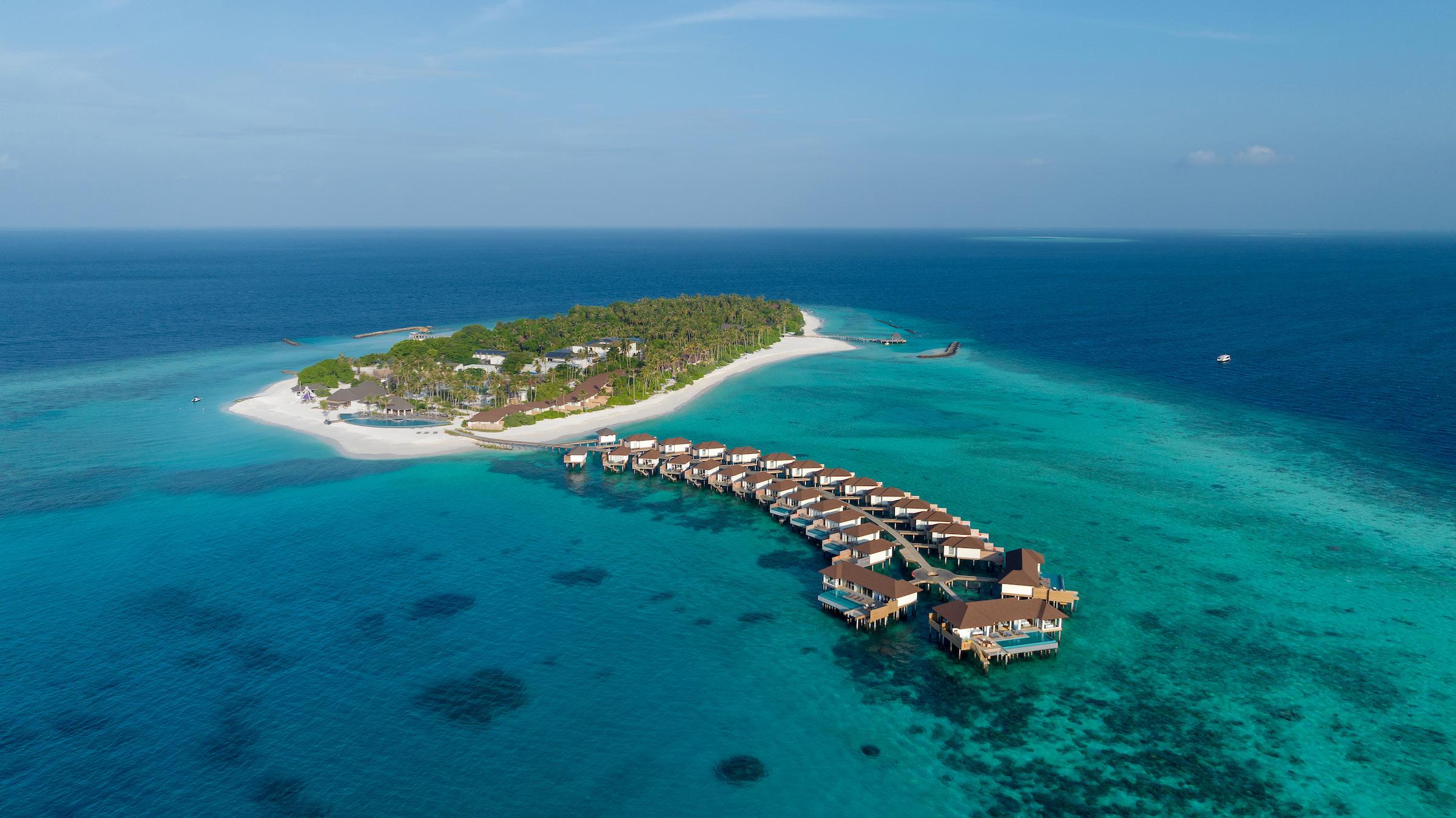
transportation. Guests can purchase the unique souvenirs, handicrafts, and other goods that showcase the rich cultural heritage of the Maldives. From handmade jewelry to traditional textiles, each item tells a story and allows guests to take home a piece of the destination's authentic charm. By patronizing the gift shop, guests not only support local communities but also contribute to the resort's broader commitment to responsible tourism and sustainable development.

Yet Avani+ Fares’ dedication to sustainability extends far beyond its physical infrastructure. Community awareness and involvement are integral to its ethos, echoing the Maldives' strategic approach to fostering low carbon growth. The resort actively engages with local communities, empowering them through educational initiatives and economic opportunities. From supporting artisanal crafts to promoting sustainable fishing practices, Avani+ Fares is a catalyst for positive change, fostering resilience and self-reliance in the face of climate adversity.
Avani+ Fares also embodies a vision of holistic wellness that transcends mere luxury. AvaniSpa guests are invited to reconnect with nature and nurture their well-being amidst the breathtaking beauty of the Maldives, fostering a deeper appreciation for the fragile ecosystems that sustain us all. Whether indulging in rejuvenating spa treatments or embarking on short ecoconscious, careful excursions to dive, snorkel, or see where the dolphins, turtles, manta
rays, reef sharks, whale sharks, and other sea life cluster, every experience at Avani+ Fares is imbued with a sense of purpose and mindfulness.
Avani+ Fares features the most exceptional AvaniKids and Teens Club I've encountered, featuring both captivating indoor and outdoor spaces, complete with splash play area and gaming chill out zone. Undoubtedly one of the most remarkable family
 Outdoor bathroom at the over water villas.
Outdoor bathroom at the over water villas.

hotels in the Maldives, Avani+ Fares offers an entire realm waiting to be explored by both parents and children. A plethora of facilities and activities await youngsters and teens, including a first kids-only restaurant, Petit Bistro, and workshop areas that even house a quiet room for reading and napping. There's no shortage of young entertainment against the backdrop of this breathtaking Maldivian family resort.
“At Avani+ Fares Maldives Resort, we prioritize sustainability, attention to detail, and ocean engagement in managing our overwater villas. Our commitment to preserving the pristine environment of the UNESCO Baa Atoll Biosphere Reserve drives us to adopt eco-friendly practices such as solar power, plastic-free amenities, and responsible sourcing,” said Riaan Drever, general manager of Avani+ Fares Maldives Resort. “This ensures that the natural beauty of our surroundings remains intact for generations to come.”
He continued, “Every Avani Over-Water Villa offers expansive ocean views without compromising privacy, providing guests with an immersive experience. We empower guests to explore the ocean in an eco-conscious way through education on responsible spotting, swimming, and snorkeling practices. Our resort offers opportunities for guests to actively contribute to marine biology and coral reef protection programs.”
As I reflect on my time at Avani+ Fares, I am reminded that sustainability is not merely a buzzword, but a fundamental imperative for our collective future. In the Maldives, where the specter of climate change looms large, Avani+ Fares stands as a beacon of hope, demonstrating that luxury and environmental responsibility can coexist harmoniously. As we strive to combat climate change and mitigate its impacts, let us draw inspiration from the visionaries at Avani+ Fares and embrace a future where sustainability is synonymous with paradise.








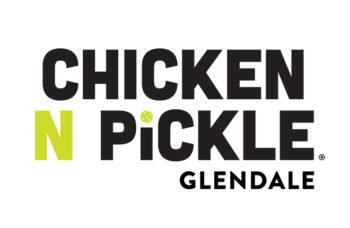








Central
LLocated just an hour south of Indianapolis, Bloomington, Indiana—along with its neighboring cities to the east, Nashville and Columbus—offers a surprising mix of activities for a variety of travelers. The tri-county area recently launched Project 46, a climate collaboration plan that embraces four common goals: to track and report greenhouse gas emissions; to coordinate local investments and leverage available state and federal funding opportunities; to promote best practices; and to produce an annual community report that demonstrates the impact of these efforts.
Nestled within the Hoosier National Forest, Bloomington boasts the state’s largest lake and plenty of adventure opportunities for nature lovers (including paddle sports and boating, plus hiking, mountain biking, and birdwatching). The city also bustles with art, culture, and a burgeoning brewery and distillery scene. Bloomington is consistently named one of the best college towns in the United States and is home to the Tibetan Mongolian Buddhist Cultural Center.
Meanwhile, the city’s Center for Sustainable Living is a non-profit that currently supports 12 sustainability projects. Bloomington also is home to numerous art installations made from recycled materials. Furthermore, Walk Friendly honored Bloomington in 2020 for its commitment to improving and sustaining walkability and pedestrian safety. And in 2022, Bloomington received a Gold designation from the national SolSmart program for advancing the growth of solar energy. The City of Bloomington also has several sustainability initiatives, such as Compost
Up, Downtown program, which supports downtown restaurants in composting efforts.
The Graduate Bloomington, located on Kirkwood Avenue near the Courthouse Square’s shops and restaurants, is a pet-friendly hotel with loads of amenities. In addition to a rooftop terrace, the Hoosierinspired hotel features beautifully designed rooms and suites (there’s even a Stranger Things suite inspired by character Joyce Byers’ living room), refillable Malin + Goetz bath essentials, bike rentals, a 24-hour fitness center with Peloton bikes and the Poindexter diner serving breakfast and lunch. 210 E. Kirkwood Ave., 812-994-0500, www.graduatehotels. com/bloomington

The Hundredth Hill Artist Residence & Retreat, set on 50 acres of pristine woodlands and trails, features four private guest residences that have been built using upcycled materials and items harvested from the land. The retreat flaunts a professional recording studio, an open-air barn for performances, and an outdoor stage. It’s geo-thermally heated and cooled and will soon embrace solar and wind-powered additions. Book the Arists’s Airstream and enjoy a queen-sized heated bed, full kitchen, enclosed screened porch, and sunken Japanese soaking tub. 8275 N. Fish Road, www.thehundredthhill.com
Downtown’s Fourth Street, also known as International Row, is home to nearly 20 restaurants serving an array of global cuisine from Tibetan, Korean, and Cajun to Burmese, Greek, Indian, and Thai. Try popular spot Anyetsang’s Little Tibet, which offers specials like mo mos (dumplings), kham amdo thugpa (a hearty stew), and temo sha tsel (stir-fried vegetables in a garlic sauce). The restaurant also serves Indian and Thai dishes. 415 E. 4th St., 812-331-0122, www.anyetsangs.com
Upland Brewing Co. has been brewing local beer since 1998 and features a pet- and child-friendly patio that’s perfect for enjoying a pint or two. The brewery also has a robust food menu with items such as nachos, salads, sandwiches, steak, and seafood, plus vegetarian and vegan dishes like the Nashville hot seitan. 350 W. 11th St., 812-364-2337, www.uplandbeer.com
For something a bit stronger, head over to Cardinal Spirits for cocktails, food, and a distillery tour and tasting. Grab a spot in the tasting room and try a bevy of liquors, from the Four Grain Bourbon to the Blackstrap Rum. The distillery also offers canned cocktails — the newest version is a pick-me-up called the Songbird Spiked Cold Brew. 922 S Morton St., 812-202-6789, www.cardinalspirits.com
For those who prefer wine, be sure to visit Oliver Winery. Expect approachable, fruit-forward wines that range from classic varietals to crisp apple ciders and sweet experiments. The winery has been crafting wine for more than 50 years and grows unique grape varieties—such as Catawba, Chambourcin, Vidal

Blanc, and Vignoles — on its Creekbend Vineyard. 200 E. Winery Road, 812-876-5800, www.oliverwinery.com
Make time to visit Indiana University’s main campus in Bloomington, which is home to some of the country’s most esteemed libraries and museums. For example, the IU Eskenazi Museum of Art (designed by world-renowned architect I.M. Pei) houses ancient gold jewelry, African masks, and works by Claude Monet and Pablo Picasso. Meanwhile, the Lilly Library — one of the largest rare book and manuscript libraries in the country — has a collection of more than 400,000 books, 100,000 pieces of sheet music, and 7.5 million manuscripts. 107 S. Indiana Ave., 812-855-4848, www.bloomington.iu.edu
The Tibetan Mongolian Buddhist Cultural Center & Kumbum Chamtse Ling Monastery, founded by the 14th Dalai Lama’s brother, Thubten Jigme Norbu, in 1979, serves as a hub for Tibetan Buddhist teachings, Tibetan and Mongolian cultural preservation, and community activities. The center offers meditation sessions, retreats, lectures, and festivals and features a museum, library, and gardens. In addition to incorporating ecofriendly building practices and water conservation measures, the center often includes environmental stewardship in its teachings. 3655 S. Snoddy Road, 812-336-6807, www.tmbcc.org
State Forest and Brown County State Park. With more than 1,000 acres of nature to zip line, ATV, or mountain bike, there are plenty of opportunities for outdoor adventure.
Brown County Barn Burner is a one-of-a-kind AirBNB featuring a rooftop patio and four separate units. A total of nine bedrooms can sleep up to 29 guests, and an event space also is available for those wishing to host gatherings (such as yoga retreats). 185 S. Jefferson St., www.bcbarnburner.com
Story Inn, Indiana’s oldest country inn (built in 1851), features 15 quaint rooms and cottages, a gourmet restaurant (with an extensive wine list and refined cuisine), a restored 114-year-old barn, and an underground tavern. Book the Schultz Homestead Back (part of the Schultz Homestead Cottage) and enjoy a queen bed, private bath with jetted tub/ shower, mini-fridge, and a porch swing with views of the horse pasture. 6404 Indiana Hwy. 135, 812-9882273, www.storyinn.com

Nashville, a charming artists’ colony nestled between Bloomington and Columbus, is located in picturesque Brown County. The historic downtown is home to antique stores, galleries, and the Brown County Art Guild (featuring works by more than 40 local and regional artists). Pristine natural areas include the Hoosier National Forest, Yellowwood
Hard Truth Distilling Co., known for its spirits like Maple Bourbon Cream and Hard Truth Toasted Coconut Rum, also offers tours and activities, festivals, and Hard Truth on the Rocks (a terraced outdoor area with a stage for live music, food truck and bar that operates seasonally). The company also partners with agriculturally focused, not-for-profit organizations that provide resources and support to family farmers. 418 Old State Road 46, 812-720-4840, www.hardtruth.com
Nicknamed the Little Smokies because of its resemblance to the Great Smoky Mountains, Brown County State Park is Indiana’s largest state park. The property encompasses nearly 16,000 acres, and it’s a
stop on the Indiana Birding Trail. Be sure to climb the 90-foot fire tower for a breathtaking view. 1801 IN-46, 812-988-6406, www.in.gov/dnr/state-parks
Mountain Tea State Forest is one of the planting sites for the Division of Forestry’s ForestIN program, an effort to plant one million trees by 2025. It encompasses more than 1,153 acres and is a great spot for hiking, picnicking, and birdwatching. www.in.gov/ dnr/state-parks
Tour the Brown County Art Guild to learn why it is dubbed the Art Colony of the Midwest. Dating back to the late 1800s, the guild curates its permanent collection, supports and showcases current guild artists, and creates experiences for visiting guests. 48 S. Van Buren St., 812-988-6185, www.browncountyartguild.org
Also be sure to visit the Brown County Art Gallery, which is one of the oldest art galleries in the country. In addition to permanent collections and rotating exhibitions, the art gallery offers workshops and events. 1 Artist Drive, 812-988-4609, www.browncountyartgallery.org
Located one hour east of Bloomington, Columbus is known for its worldclass architecture and public art. In fact, Condé Nast Traveler called Columbus “one of the world's best cities for architecture lovers,” with designs from the likes of I.M. Pei and Eero Saarinen.
Hotel Indigo Columbus Architectural Center is within walking distance of Mill Race Park, the Fourth Street Entertainment District and the Columbus Visitor’s Center. The pet-friendly hotel, which also has its own gallery spotlighting regional artists, features an indoor pool and whirlpool, fitness center, and The Gallery Bar and Bistro. 400 Brown St., 877-846-3446, www.ihg.com/hotelindigo
For a fun night out and delicious fare, check out Henry Social Club. Chef/owner Gethin Thomas has created a rotating menu of seasonal dishes focused on homemade breads, salads, pasta, steaks, and more. The sleek interior begs for long conversations while sipping an inventive cocktail or a glass of wine. 423 Washington St., 812-7991371, www.henrysocialclub.com
Step back in time at Zaharakos Ice Cream Parlor and Museum, which opened in 1900. The nostalgic ice cream parlor flaunts stained glass mirrors, pre-1900 soda fountains, and a 50-foot mahogany back bar. It also houses a museum room, soda fountain library, and mechanical music library. Zaharakos also has a hefty menu of starters, burgers, sandwiches, and more. 329 Washington St., 812-378-1900, www.zaharakos.com
450 North Brewing opened in 2012 and features 30 taps of beer, cider, and wine. Canned beers range from the Copperhead amber ale to the Citra Nuggets double dry-hopped double IPA. Pair a brew with a salad, sandwich, or some brick oven-fired pizza. 8111 E. 450 North, 812-546-0091, www.450northbrewing.com

Since the early 1940s, world famous architects — such as Kevin Roche, Eero Saarinen, I.M. Pei, Richard Meier, and others — have shaped Columbus into a virtual museum of modern architecture. Book a guided Architectural Highlights Tour with Visit Columbus to discover how this small Midwestern town became a modern architecture destination. The two-hour tour begins and ends at The Columbus Visitors Center. 506 5th St., 812-378-2622, www.columbus.in.us
While at the Columbus Visitor’s Center, book a 90-minute tour of the Miller House and Garden. As one of the most important mid-century modern residences in the country, Miller House ranks with other notable residences — such as Fallingwater, The Glass House, and The Farnsworth House — as a hallmark of modern design. 506 5th St., 812-378-2622, www.columbus.in.us

IIn Southern California, the vines are as green as they are gloriously gratifying. Nestled just an hour inland from San Diego, and just a five-hour drive from the Valley, Temecula – named among the “Top 10 Wine Destinations in the World” by Wine Enthusiast magazine – boasts nearly 50 unique wineries and vineyards, as well as several dozen award-winning eateries and epic overnight accommodations, almost all operated with sustainable practices at the forefront.
The only state winery to claim the title of California Winery of the Year five times at the California State Fair Wine Competition, South Coast is situated on 63 lush acres and features a grand resort with 132 rooms and magnificent villas, the Grapeseed Spa, and the lauded Vineyard Rose Restaurant in addition to its full-scale vineyard, the wines from which are 100% estate grown, bottled, and Certified Sustainable. Among its biggest priorities is fostering an authentic ecosystem management program that allows for farming within the natural location.
South Coast’s sister property, Carter Estate, opened in 2015 and by 2018 became Certified Sustainable, balancing wine quality with water and energy conservation at the highest level possible. Like South Coast, Carter also offers wine country accommodations and a long list of award-winning varietals. Its vineyard bungalows are most impressive, especially if in the mood for romance. Carter also offers wine tasting packages that offer sipping, a luxurious stay, and a bevy of on-property and nearby attractions, including a two-hour private horse drawn carriage ride through its estate vineyards.
WILSON CREEK WINERY
Eagle-eyed oenophiles will recognize the breathtakingly gorgeous grounds at Wilson Creek from its many appearances in pop culture, notably on The Real Housewives of Orange County, Blind Date, The Golf Channel, and even on Oprah’s OWN Network. Beloved world-wide for its almond champagne, Wilson Creek, however, is more than just a pretty face. A veteran conservation steward in the region and advocate of regenerative farming, the winemaking team performs plant sap analysis and biological soil analysis for the application of biologically based fertilizers, leading to increased soil carbon and balanced bacteria-to-fungi ratios. They also extend their eco practices beyond the vines. Impressively, wine tank wash water is recycled within the tank, reducing the need for large volumes of water. They use a high-efficiency refrigeration system, and all wine bottles and paper products are recycled on a weekly basis.
All the work shows in every bottle produced on property, of which there are many, given that Wilson Creek grows and produces 15 types of wine ranging from classic varieties like Cabernet Sauvignon, Chardonnay, Zinfandel, and Merlot,
to Rhône varieties such Syrah, Viognier, Roussanne, and more. When visiting the winery, guests can sample a little of everything thanks to a bevy of tasting options (some with food pairings) and even the option to taste at the lauded, dog-friendly eatery on property, Creekside Grille.
Truly sustainable since 1986, today three generations of Bailys are growing grapes and making wine with the purpose of maintaining the winery and vineyards for the generations of Bailys to come. In the early 2000s, Baily Vineyard & Winery was one of the first wineries in California to participate in the Wine Institute’s sustainability program and is now a Certified California Sustainable Vineyard & Winery. Such a certification means that all the sustainability boxes have been checked, but the winery especially prides itself on its water conservation practices and the virtual elimination of caustic sanitation products, relying primarily on ozone and steam for disinfecting tanks, barrels, equipment, and floors. Since 2002, the winery has been operating under a Special Waste Management Permit from the Regional Water Quality Control Board to ensure that all wastewater is measured, tested, and disposed of properly. The winery specializes in wines made from the traditional Bordeaux varieties: Cabernet Sauvignon, Cabernet

Franc, Merlot, Malbec, Sauvignon Blanc, and Sémillon. Baily’s winemaking style is best described as “Old World,” meaning that the wines have lower alcohol levels and higher acidity, making them clean and fresh on the finish and best enjoyed when paired with compatible foods.
Every year since 2011, Ponte Winery has continued to meet the ever-expanding requirements to maintain its Certified California Sustainable Winegrowing designation. By way of example, they use compost to return beneficial organic material to the soil, install owl nesting boxes to promote natural pest control, and practice responsible watering to make their Italian, French, and Spanish varieties.

Ponte is connected both to a restaurant and lodging as well as a basement speakeasy, so when visiting, save some room on the itinerary to enjoy a perfect martini or Old Fashioned.
BOTTAIA Winery is part of the Ponte Family and also keeps sustainability a close part of all operational practices. This includes the reduced use of plastic and disposable items for its service departments in its tasting rooms and seasonal café, employing various methods and practices in both its winemaking facility and vineyard farming that result in reduction of herbicides by 80%, and even using one less tractor during harvest to cut down on emissions. At BOTTAIA, enjoy a unique collection of Italian varieties, including
Montepulciano, Sagrantino, Verdicchio, and Pecorino to name a few.
A proud member of the California Sustainable Winegrowing Alliance, Robert Renzoni leads the way in all things sustainable, including water conservation techniques, careful canopy management practices, compost spreading, planting annual cover crops, eliminating all pesticide spray, and weeding manually throughout the property. It is also 100% solar powered. When visiting, do not miss the combination of predominantly Italian varieties, including Vermentino, Pinot Grigio, Sangiovese, Barbera, and Montepulciano with a pizza slice or two from its onsite trattoria, inspired by the owner’s own family recipes.
Certified by the California Sustainable Wine Growing Program in both the winery and the vineyard, Palumbo is a member of the Santa Margarita watershed monitoring program and utilizes ADCON weather station monitors to help identify vineyard issues so it can proactively react to weather situations that might otherwise require nonorganic pesticide or fungicide interventions. They also recycle and compost all grape and post-fermentation waste to better reduce their carbon footprint and help replenish their soils. When at the tasting room, make note of the bar and interior space, which were constructed almost entirely out of recycled and repurposed materials.
convertible shuttle. The 18-person luxury tour vehicle allows all guests to enjoy fresh air and 180-degree views of Temecula between vineyard visits.
For a view that will take everyone’s breath away, make a reservation at Callaway Winery. An innovator in the area, it was founded by Ely Callaway – of Callaway Golf fame – and is now privately owned by a local family. The breathtaking estate and tasting room are built high above the city and boast awardwinning Chardonnay, Pinot Gris, and Sauvignon Blanc varieties. Callaway is also home to Meritage Restaurant, an indoor-outdoor eatery with a farm-tofork mindset. The ingredients on the ever-changing

menu come from the Callaway greenhouse and garden or are otherwise sourced from sustainable local farmers.
And that all just scratches the surface of incredible, eco-friendly places to visit in Temecula.
There are nearly endless options for eco oenophiles in Temecula Valley. The best bet is to lock in a tour for at least one day of any visit. With both pre-planned itineraries that include vineyard picnics and custom tours, The Grapeline is a great option, especially since debuting the world’s first Mercedes hardtop Sprinter
Among the most immersive experiences in the area is Leoness Cellars. There, opt for the Vineyard Tour & Taste, a guided adventure through the award-winning winery’s winemaking process, capped by a luxurious private tasting of their wines with artisan cheeses and other surprises.
Seeking something to do between bites and sips? Temecula also offers golf at several public courses and boasts its own Alpaca Hacienda, which is a sanctuary and farm for the gentle, inquisitive South American mammals.
Visit www.temeculawines.org for more information.
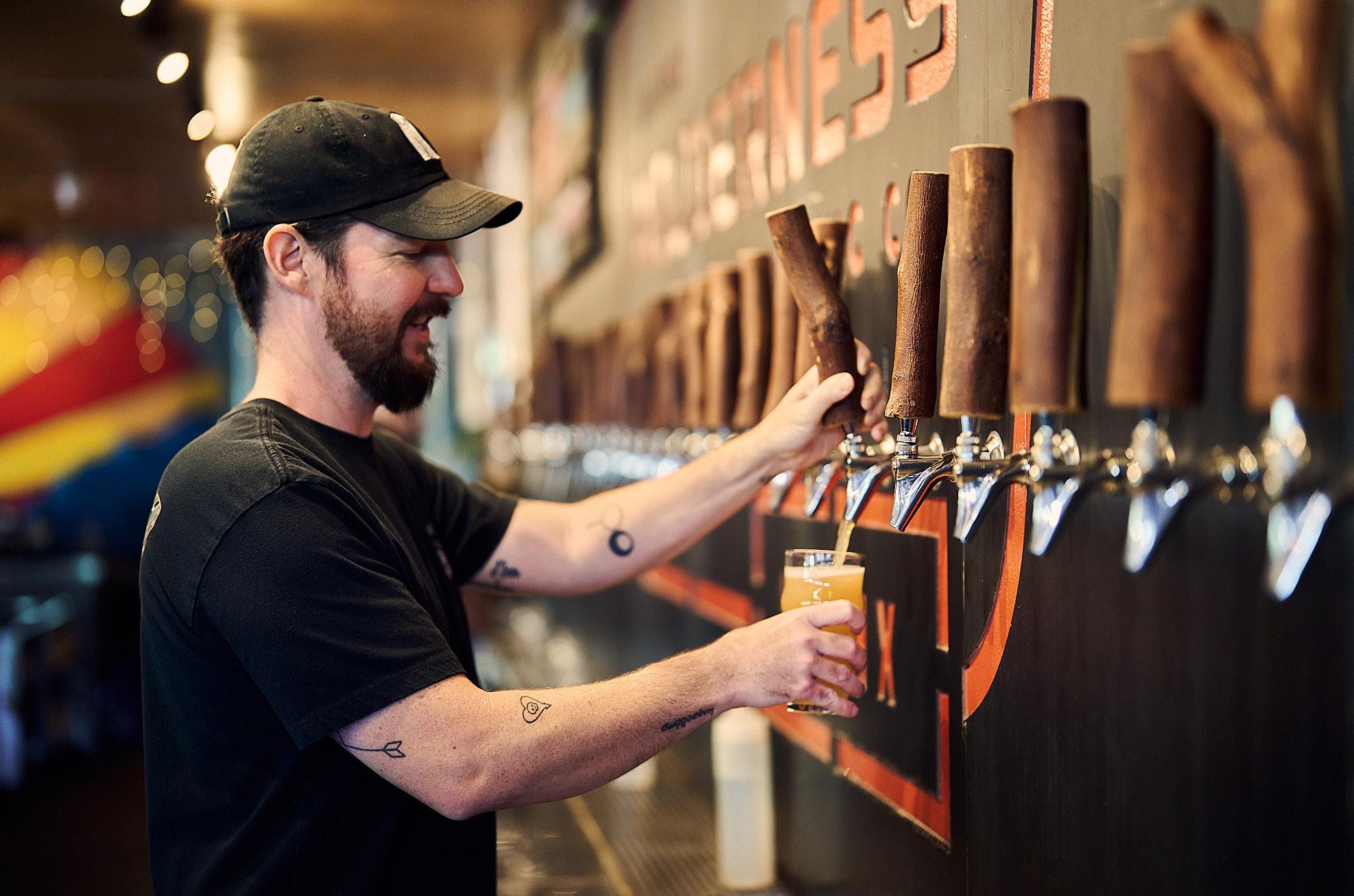
TThe Grand Canyon State is Arizona Wilderness Brewing Co.’s muse. “And we treat her as such,” said Zach Fowle, head of marketing at Arizona Wilderness Brewing Co. “She serves as our inspiration for ingredients, flavor profiles, and even our artwork, and in return we act as her advocates and protectors.”
Founded in 2013 and named Best New Brewery in the World by RateBeer.com — largely considered the authority on craft beer — within months of its debut, Arizona Wilderness Brewing Co. is wholly focused on two things: showcasing the diversity of local ingredients and similarly eco-conscious partners through its brews and taking care of the land that provides such a beautiful bounty.
“Jon, our founder, got the idea to create Arizona Wilderness on a backpacking trip through the outdoors. He wanted to create a company that both celebrated and protected our beautiful and diverse state,” said Fowle.
“To start, every beer we make uses a base of Sinagua Malt, which is based in the Verde Valley and works with local farmers to switch from high water-use crops like corn and alfalfa to barley, which uses much less water from the nearby Verde River,” said Fowle.
According to Fowle, this crop-switching saves more than 100 million gallons of water for Arizona's people and wildlife every year.
“Every pint of our beer that someone drinks represents more than 50 gallons saved for Arizona’s


Are you still on track for retirement?
Investors have survived market swings and corrections before. But a twinge of uncertainty may have you wondering if you should get another opinion to help confirm your wealth is in the right place. That’s why we’ve made it as easy as we can to have a complimentary, face-to-face meeting with an advisor.
The Ewing-Morales Group of Wells Fargo Advisors of Wells Fargo Advisors

18700 N. Hayden Road Suite 525
Scottsdale , AZ 85255
Direct: (480) 419-2016
mark.morales@wellsfargoadvisors.com
https://home.wellsfargoadvisors.com/mark.morales CA Insurance # 0D34255
Wells Fargo Advisors is a trade name used by Wells Fargo Clearing Services, LLC, Member SIPC, a registered broker-dealer and non-bank affiliate of Wells Fargo & Company.
©2022 Wells Fargo Clearing Services, LLC. CAR-0622-03974
waterways,” said Fowle.
Arizona Wilderness also partners with R.City, whose mission is to connect residents and businesses to local farming, closing the gap between food and where it comes from, and reducing the amount of food waste entering our landfills.
“They convert our food waste, as well as our napkins, some plateware, and even utensils into compost, and then use that compost to grow crops. Some of the crops they grow make it back into our dishes, creating a true closed loop,” said Fowle.
And that just scratches the surface.

“You know the plastic rings that keep cans of beer together? In their traditional form, they are ultra dangerous to wildlife, especially birds and fish,” said Fowle. “But not ours.”
Arizona Wilderness uses rings from E6PR, who are pioneering zero-waste packaging solutions tailored for diverse industries. As a result, its rings are 100% compostable and are even edible.
Beyond protecting wildlife from harmful plastics, Arizona Wilderness also partners with local organizations that promote environmentalism and protect the health of the state's wild areas. Notably, 2% of sales from the brand’s non-alcoholic IPA, which is cleverly called Arizo[na], are donated to the Arizona Trail Association each year.
“The Arizona Trail Association is the organization that protects, maintains, enhances, promotes, and sustains the Arizona National Scenic Trail,
which is a complete nonmotorized path from Mexico to Utah, stretching 800 diverse miles across Arizona to link deserts, mountains, canyons, forests, history, communities, and diverse peoples,” said Fowle.
The organization is also preparing to release an IPA called Earth to Beer, which will raise funds for Natural Restorations, a group that organizes monthly cleanups of areas that humans have dirtied with trash and overuse.
Even the brews that do not directly financially impact the environment protect it.
“Kernza Lager, our collaboration with Patagonia, is made with Kernza. A type of wheatgrass, Kernza is special because it’s perennial, meaning it stays in the ground year after year and doesn't need to be tilled,” said Fowle. “It also grows incredibly long roots – up to 18 feet! – that help maintain the structure and health of soil.”

Several other beers and some of the taproom’s food is made with grain from Oatman Farms, which is Arizona's only regenerative organic certified farm. Regenerative organic farming methods, from cover cropping and crop rotation to low- or no-till and composting, have the ability to rejuvenate soil and result in far fewer carbon emissions each season.
In addition to Oatman, Arizona Wilderness has about 50 similarly sustainable partners that it uses for sourcing, including Abby Lee Farms, Agritopia Farm, Apple Annie's Orchard, Arizona Farms Cheese Co., Blue Sky Organic Farm, Crooked Sky Farms, Green Valley Pecan Co., Mortimer Farms,
Pinnacle Farms, Queen Creek Olive Oil Mill, Rhiba Farms, and many more.
For Arizona Wilderness, the future is as bright as it is green. In addition to its current brewpub in Gilbert and beer garden in Downtown Phoenix, Arizona Wilderness recently purchased a building on Phoenix's historic Miracle Mile, located on
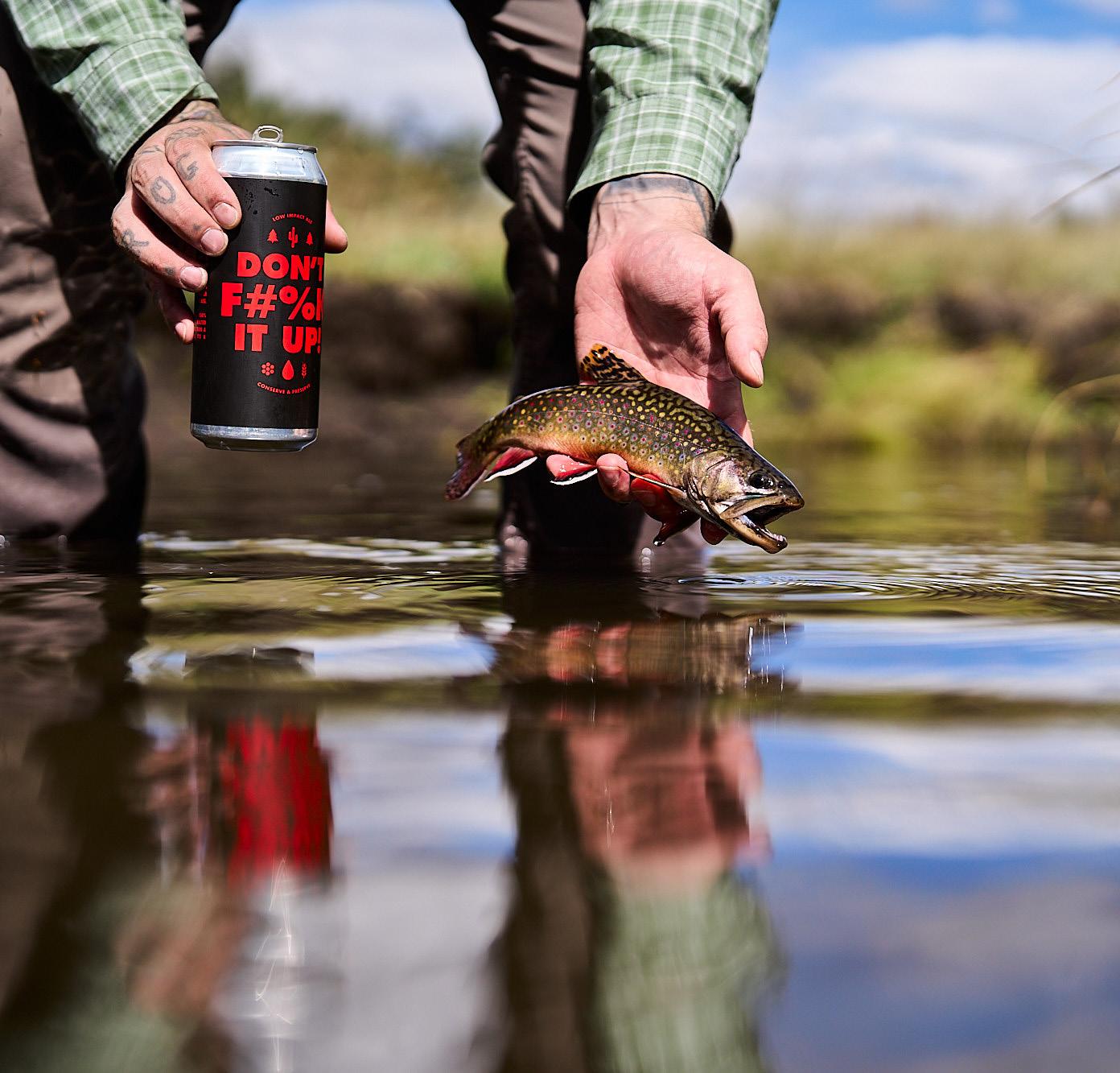

McDowell and 14th Street.
“This space will house a taproom, restaurant, and a larger brewhouse that'll enable us to dramatically increase the amount of beer we brew,” said Fowle. “We are working through approvals and construction now and hope to have the space open to the public early 2025.”
Visit www.azwbeer.com for more information.

OOver the past few years, the food industry has undergone a significant shift towards organic, sustainably grown produce. This trend, driven by a collective awareness of environmental and health concerns, has extended its reach into the realm of alcoholic spirits, where the difference is not just a matter of conscience but also discernment of the palate.
Tequila, a beloved spirit in Arizona, is witnessing a surge in popularity for its organic variant. The motivation behind this transition varies: for some, it's a quest to minimize exposure to harmful chemicals and additives; for others, it's about safeguarding the environment. However, the prevailing sentiment, echoed by experts and enthusiasts alike, is simple: organic tequila tastes better.
Crafted from blue agave plants nurtured without synthetic pesticides or fertilizers, organic tequila boasts a natural and untainted flavor profile. The production process is a testament to tradition and craftsmanship. Mature agave plants are meticulously harvested and slowly roasted in traditional stone ovens to extract their sweet nectar. This juice, fermented using naturally occurring yeasts, yields a smooth and complex flavor profile. Finally, the tequila is distilled in small batches to preserve its integrity and unique characteristics.
The difference in taste between organic and non-organic tequila is unmistakable. Organic tequila exudes authenticity, with nuances that reflect the agave fields it was cultivated in. Its flavor
profile is rich and vibrant, with pronounced earthy, floral, and citrus notes, culminating in a smoother and cleaner finish, devoid of chemical residues.
Beyond its superior taste, organic tequila is a more environmentally friendly option. By shunning synthetic chemicals and embracing sustainable farming practices, it not only enhances the drinking experience but also supports the health of the land and the communities that rely on it.
In the world of spirits, Z'Tejas serves as a purveyor of fine tequilas that is committed to quality and sustainability. At the heart of its tequila program lies a dedication to providing an unparalleled tasting experience, fueled by a range of organic varieties from brands like Casamigos, Corcel, Casa Noble, and Dulce Vida.
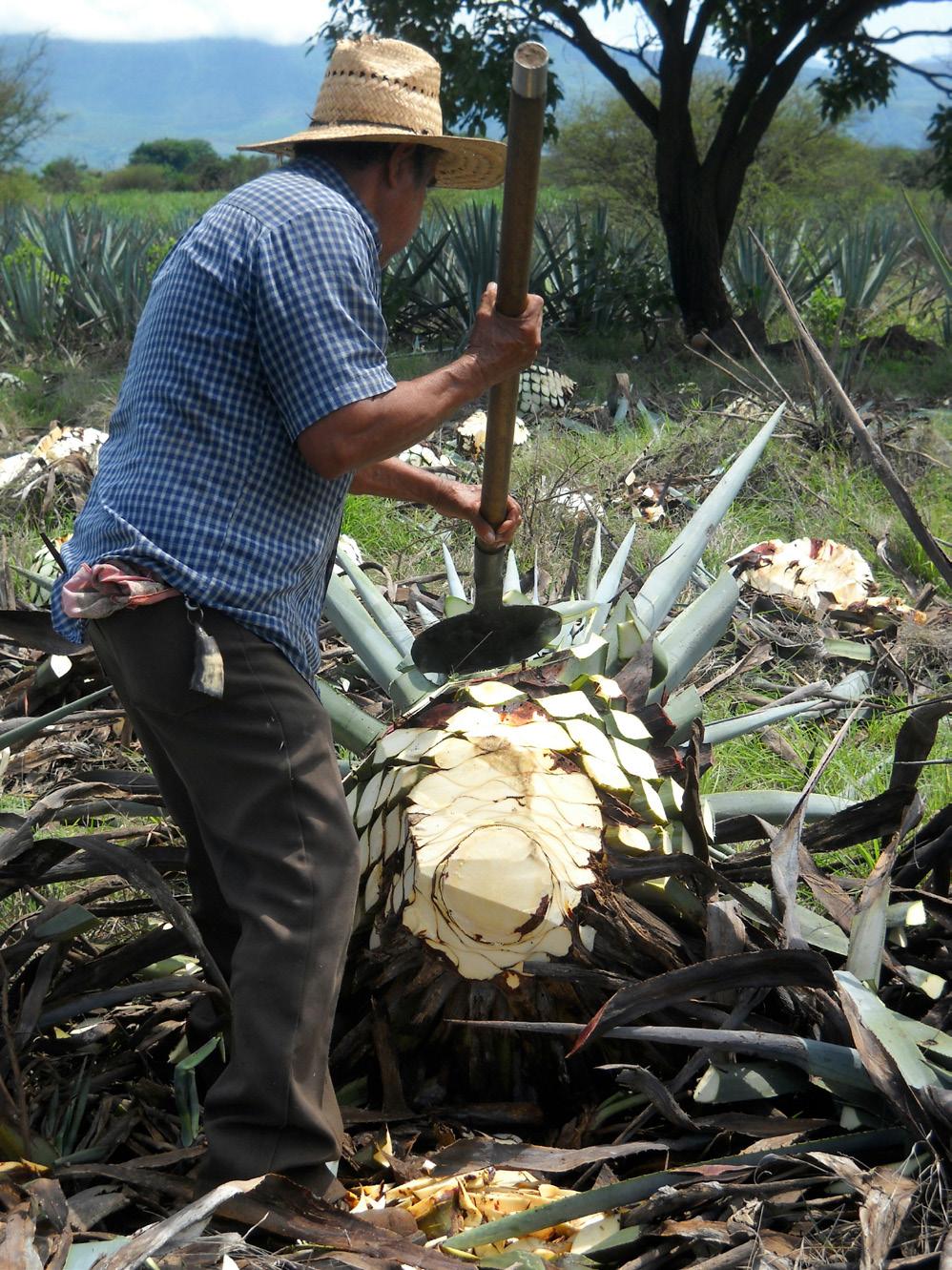
To fully appreciate the depth and complexity of tequila, Z’Tejas recommends the following tasting techniques:
Pour the tequila into a snifter or a tequila glass. Observe the color and clarity, which can give you hints about the age and quality of the tequila.

Nose: Bring the glass to your nose and inhale gently. Try to identify the different aromas, such as agave, fruit, vanilla, or wood.
Sip Slowly: Take a small sip, letting the tequila coat your tongue. Notice the initial flavors, mid-palate sensations, and the finish.
Proper storage is key to maintaining the quality of your tequila. Keep your bottles in a cool, dark place, away from direct sunlight. Unlike wine, tequila does not age or improve once bottled, so it's best to store it upright to minimize contact with the cap, which can affect its flavor over time. Sealed bottles can last for
years, while opened bottles are best consumed within a few months for optimal taste.
Through the expansion of organic tequilas within its overall collection, Z’Tejas invites guests to explore tequila's rich flavors in a manner that respects tradition, embraces sustainability, and celebrates innovation. Visit www.ztejas.com for more information or to join upcoming tequila dinners and events.

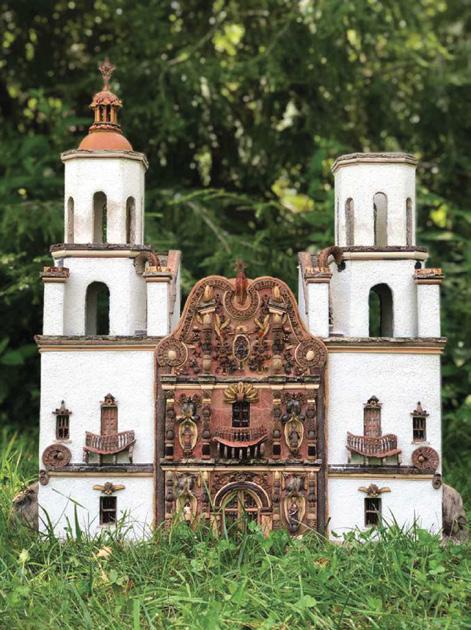


Ingredients
2 cups mixed greens
1 cup arugula
French feta
1 cup roasted yellow tomatoes (substitute roasted red tomatoes if necessary)
½ cup thinly sliced red onion
¼ cup sliced banana peppers
¼ cup sliced Kalamata olives
½ cup cucumber slices
½ cup turmeric-tahini vinaigrette
Directions:
Mix all ingredients except feta into a large mixing bowl and gently toss. Drizzle the vinaigrette over the salad and garnish with the crumbled feta.
Turmeric-Tahini Vinaigrette
3/4 cup apple cider vinegar
1 cup neutral oil (avocado is preferred)
5 tablespoons well-stirred tahini
3 tablespoons light agave
1 teaspoon fresh minced garlic
1 tablespoon Dijon mustard
1 teaspoon kosher salt
1/4 teaspoon fresh ground black pepper
1/4 teaspoon ground turmeric
4 teaspoons cold water
Mix all ingredients except oil and blend with an immersion blender or in a food processor. Once blended, slowly add oil and continue to blend until dressing thickens.


MAKES 1 SANDWICH
Ingredients
1 brioche roll
2 teaspoons salted butter, softened
1 teaspoon olive oil
1 oz. button mushrooms, finely chopped
1 ½ tablespoons roasted red peppers, chopped
1 tablespoon scallions, thinly sliced
1 pinch of salt
2 eggs
1 slice Swiss cheese
1 ½ tablespoons basil pesto
Directions
Cut brioche roll in half using a serrated knife. Butter the inside of both halves and grill over medium heat on a non-stick griddle or pan. Remove when golden brown.
Using an 8-inch non-stick pan, heat olive oil over medium heat for 10-15 seconds. Add chopped mushrooms and sauté briefly until just cooked, approximately 30 seconds. Add the roasted red peppers, scallions, and salt and continue to sauté until all ingredients are heated through. Crack the eggs and add to the pan (ensure eggs remain whole - do not scramble).
Allow the eggs to cook undisturbed until the whites begin to set, approximately 60-90 seconds. Once the egg whites have begun to set, use a rubber spatula to break the yolks and gently stir the egg mixture. Continue to cook over low heat until the egg whites are fully set and the yolks are cooked yet soft. The egg mixture will take on a scrambled appearance, however the whites and yolks should remain distinctly visible.
Place the sliced Swiss cheese on the bottom half of the grilled brioche roll. Place the egg mixture on top of the Swiss cheese. Spread basil pesto evenly across the top half of the roll, combine the halves together and enjoy!


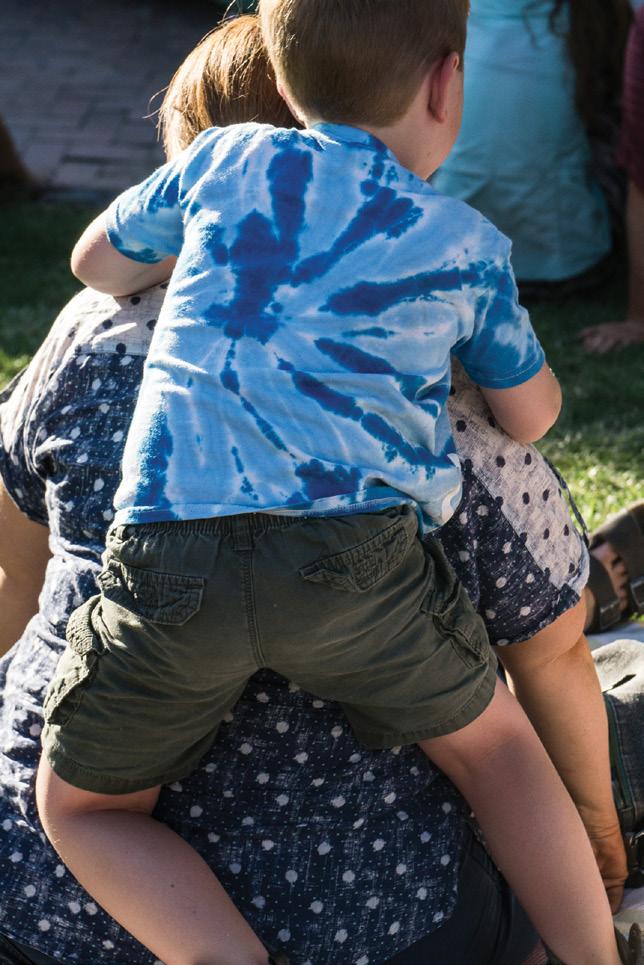
a music industry photographer’s time behind the lens inspired a connection
VVeteran entertainment photographer David Alexander recently unveiled a stunning debut book, Pictures of Time, offering a fresh perspective on humanity and our connection to the planet.
For decades, Alexander photographed legendary album covers for artists like The Eagles, Aretha Franklin, Lynyrd Skynyrd, James Brown, Ringo Starr, Tina Turner, Tom Petty and the Heartbreakers, and The Steve Miller Band, along with movie posters for iconic films like The Terminator and 9 to 5. But beyond the commercial success, Alexander began to see a deeper message woven into the fabric of his work.
Pictures Of Time: Seeing Time in the Ordinary World is a captivating collection of photographs that reveal the interconnectedness of all living things.
Alexander tells me, “Each page spread in Pictures of Time presents similarities and connections among different living and natural things. These similarities
and connections didn’t spring up overnight. They evolved from the distant past and will continue to evolve into the unknowable future. Therefore, they offer glimpses of time.”
Through his lens, Alexander finds the extraordinary in the ordinary. A group of people sitting together on a lawn is reflected in a photo of wildflowers bunched together, soaking up the sun; a family's connection echoes in the vibrant energy of manzanita trees.
Says Alexander, “It’s now widely, if not universally, believed that trees communicate with and support each other through their roots. We certainly know that people communicate with each other through words, music, touch, and in so many other ways. If




that’s true about trees and people, then I’ve had to ask myself why other life forms wouldn’t communicate with others of their species.”
In his countless hours photographing nature, he notes that he’s wondered about intraspecies communication when taking pictures of flowers, trees, and other wild species.


“The more I photographed, the more convinced I became that intraspecies communication occurs,” he says. “A look at the other page spreads in Pictures of Time shows a broad variety of similarities and connections that I believe build a consistent story of relationships across disparate living and natural things.”
Organized by themes like Shape, Pairing, and Rhythm, the book presents a beautiful tapestry of full-color photographs. Flowers blooming, trees aging, and even people relaxing in a park all seem to share a silent conversation across time.
Pictures Of Time isn't just a visual feast; it's a window
into the profound beauty of everyday life, and a testament to Alexander’s ability to find profound meaning in the seemingly ordinary, reminding us of our place in the grand flow of time.
This book will resonate with anyone who appreciates art, photography, nature, or simply ponders the larger questions of existence.
“I am a photographer who has been looking closely at life since I picked up a camera over 55 years ago,” Alexander says. “Through my experience, I’ve come to believe in the power of close observation and the value of photography of the everyday world as a means of not just showing but exploring life on this planet.”
Alexander is also the founder of A&I Color, a renowned film processing lab, and co-founder of X-DAM, a digital asset management company trusted by Fortune 500 giants like NBCUniversal, Viacom, and The Hallmark Channel. His book is available on Amazon and at www.picturesoftime.com.





We are looking for experienced newspaper, magazine, and digital media Advertising Sales Representatives.
We are seeking candidates who have demonstrated skills in the following areas:
• Direct, in-person, B2B sales, especially in the advertising field
• The ideal candidate will have two to five years of sales experience
• The Ad Rep will report directly to the Publisher
Responsibilities include the following: direct, inperson B2B sales of advertising for print, website, and e-Marketing formats in addition to sponsorships for eco events and summit events, through a relationship-based approach, being articulate and professional in both communication and appearance.


www.greenlivingmag.com/careers
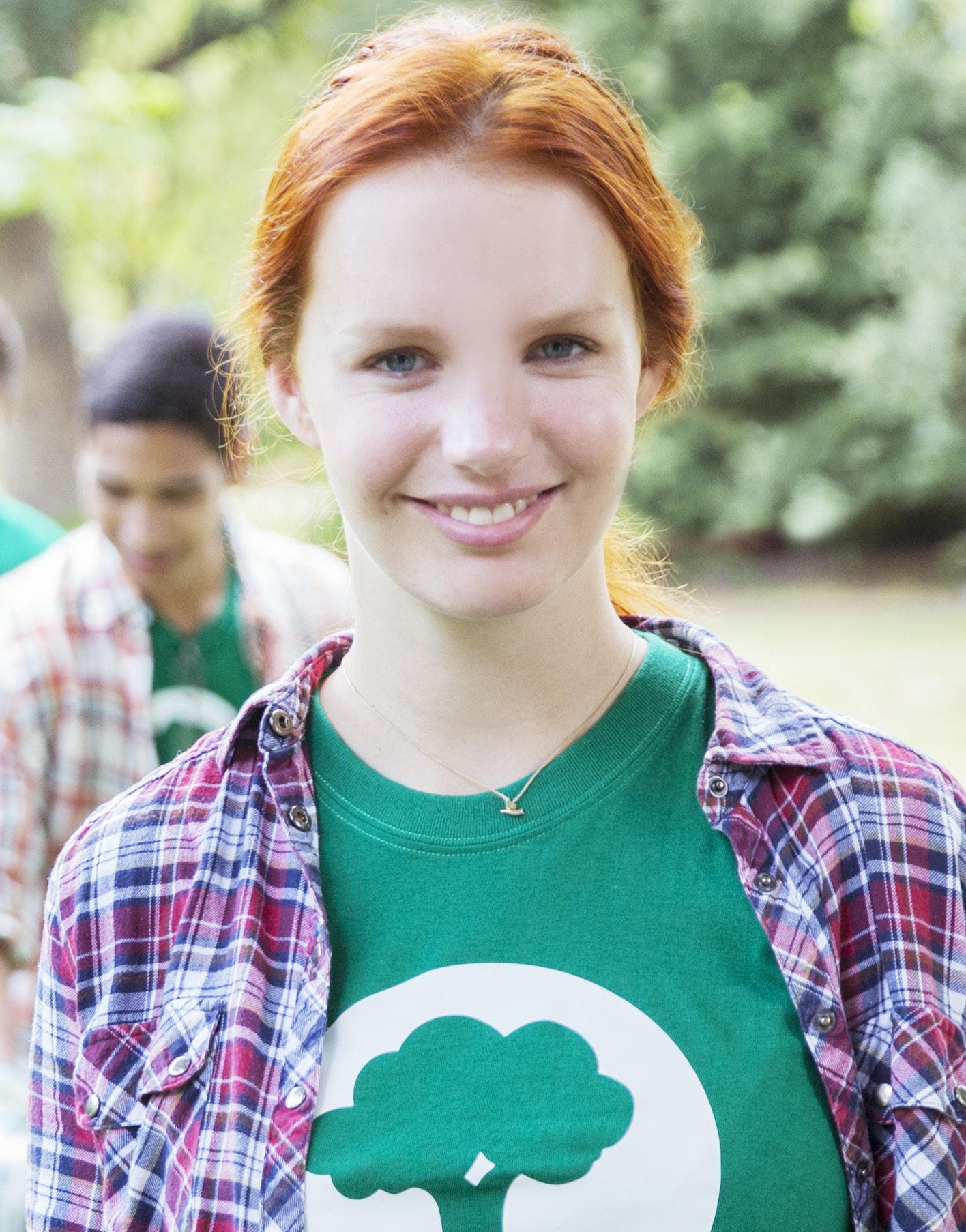

PPhoenix, Arizona. As a growing metropolis in the heart of the desert, the city has long been synonymous with car culture. With a staggering seven million cars, seven parking spots to each car with a utilization rate of just five percent, and a seemingly endless grid of highways and parking lots, it’s evident that the city has been designed around automobiles rather than its residents. However, this reliance on cars has come at a cost, contributing to air pollution, urban sprawl, and a lack of community cohesion.
As the fifth largest city in the U.S., Phoenix has great transformative potential but faces unique challenges exacerbated by its desert climate, including scorching temperatures reaching record highs. With over 100 days of poor air quality annually — and the most recent summer season hitting 110 degrees for 54 consecutive days — the need for a paradigm shift in transportation infrastructure has never been more urgent.
What if we were to draw inspiration from other carefully planned cities across the globe, amalgamating their successful elements into a tailored formula for Phoenix, allowing our city to evolve into a thriving hub of innovation and sustainability? What if we imagined a system, a ‘Vehico-System’ if you will,
aimed at redefining public transportation in Phoenix? Leveraging existing technologies such as autonomous vehicles (Waymos) and incorporating future innovations like eVTOL (electric vertical takeoff and landing) transportation, we could create a system that offers a hyper-efficient mobile metropolis that would prioritize the needs of its residents over individual cars. It could be a system that provides constantly moving vehicles for the public and requires less parking.
This could begin by reimagining the city's infrastructure and dedicating a strategic portion of the existing grid system to this Vehico-System. As an example, claiming a transit lane every second main street within the grid system, as well as repurposing
the existing HOV lanes for this people-centered system — to include autonomous vehicles, buses, and potentially a rail line — would provide a reduced reliance on private cars. This could not only alleviate traffic congestion but also free up valuable real estate currently occupied by empty parking lots.
But what about the convenience of using your own personal vehicle? This Vehico-System could tackle the inefficiency and unreliability of traditional public transportation. By implementing a hyper-connected network that ensures users never have to wait more than five minutes in uncomfortable outdoor conditions, the system would need to enhance accessibility and convenience. Through the integration of AIassisted apps, users could seamlessly navigate the city, optimizing routes for speed, cost, comfort, and safety.

The system would promote a much-needed pedestrian-friendly infrastructure, addressing the city's alarming rate of pedestrian fatalities. By redesigning shaded and safe pedestrian routes and reclaiming ground floors of buildings for public use, Phoenix can become a more walkable and connected city, fostering community cohesion and improving public health.
Beyond practicality, the VehicoSystem could aim to transform public transportation into a premium experience. By strategically pairing transit stations with popular destinations, the system becomes an amenity, attracting both tourists and commuters. This shift in perception from public transportation as a last resort to a sought-after mode of travel contributes to positive densification and sustainability, ultimately reimagining Phoenix's living culture. Future developments could be influenced to build around these transport hubs.
And why stop there? The Vehico-System could extend connectivity beyond city limits, linking neighboring cities
through rail networks. By facilitating regional transportation, Phoenix can foster economic growth and cultural exchange while reducing dependence on individual cars
In the pursuit of realizing the vision of a system like this, the concept of Public-Private-Partnerships (P3s) emerges as a pivotal strategy. By harnessing the strengths of both the public and private sectors, P3s could offer a pathway to expedite the implementation of innovative transportation solutions that catalyze positive change to shape the city's future as a model of sustainable urban mobility.
Ultimately, the Vehico-System could represent a fundamental shift in how we envision transportation in Phoenix. By prioritizing the needs of residents, reducing reliance on cars, and fostering community connectivity, a system like this could pave the way for a more sustainable, livable, and vibrant city.

Your first thought when you have health issues like pain, insomnia, or sinusitis probably isn't to poke a piece of metal into your skin. But if the practice has been around for thousands of years, there might be something to it, right? The practice is part of Traditional Chinese medicine called acupuncture. It's all about unblocking the flow of energy in your body to restore health. We were intrigued and had to know what “community” acupuncture was all about.
She Said: The only time I've tried acupuncture before was to induce labor (which worked, by the way!) and that was over 12 years ago. So, this was basically a new experience. Our talented LAc (licensed acupuncturist), Zoe, was warm and welcoming and had curated a relaxing communal space with several beds and recliners.
After a chat to find out what I'd like help with, she placed needles on my scalp (ouch), wrists, knee, calves, shins, ankles, feet, and one on the belly (didn't even feel that one, surprisingly). Recliners are absolutely the way to go. It was like a giant cozy hug to soothe my anxiety about what felt like a thousand little pokes. I will say, though, Zoe was very quick and gentle with those hair-like tiny needles, and any that continued to sting were removed when asked. After placement, I didn't feel any of the needles for most of the time I chose to relax in my chair. And relax, I did! I somehow went through a time vortex because 30 minutes felt like 10. I couldn't sleep, but I did spend some time trying to channel warm vibes to my frozen feet. If you go, say “yes” to a blanket — trust me. And if you really want to zone out, I do recommend a private appointment. The lady next to me had no qualms about practicing LOUD breath-work. I tried hard to focus on the fuzzy shadows flowing behind my eyelids, but the mouth-breather was too distracting. You may get lucky, though, and get a quiet room. The community healing aspect really is nice and a more affordable option. And if I'm being honest, my knee has felt better since the visit! The whole experience was easier than I thought it would be and I would definitely do it again.


HeHe Said: We signed up to be human pincushions this month. We looked down at our arms and legs and said, “Ya know, there are not nearly enough pieces of metal hanging out of our skin. Let's remedy that immediately.” Normally that kind of talk would have me very concerned, but I've done this particular type of torture – uh, treatment – many times before. See, I suffer from a lovely condition called migraine headaches (thanks for passing that one down, Mom) and acupuncture has been known to have very positive effects. It makes sense, since acupuncture is meant to keep the energy flow (called “Qi”) balanced along the meridians, and migraines are a neurological disorder. Unfortunately for me, I didn't notice any meaningful changes when I was doing acupuncture regularly. This session was a bit different than my previous ones, though. It was “community,” so it was one big room with multiple tables and chairs. There were already two peopleporcupines on tables when we walked in. We were greeted warmly upon entering, and after a quick consultation about my ailments, my practitioner began. She started by taking five steps back and throwing the needles at me like darts at a dart board...I'm kidding! She inserted the super tiny needles with a tiny tap. Half of them I couldn't feel go in, and the other half were like a slight pinch. I could feel a rushing sensation in certain areas, especially my arms. Once I was all pinned up, she gave me a blanket and I snoozed for like 40 minutes. I really wish I could tell you this cured me of migraines, but it didn't. I ended up getting one that same day (ugh).






Phoenix Global Forum 2024: Forging the Future
The Phoenix Global Forum will act as a platform where decision makers, thought leaders, and experts in their respective fields convene to discuss society’s evolving needs amidst ongoing global challenges. The forum will examine solutions already in development, both in Phoenix and worldwide, while also fostering future innovation through connection and collaboration. The Phoenix Global Forum is hosted by the IEFA and Phoenix Sister Cities and will launch in Spring 2024. The Phoenix Global Forum is held at the Arizona Biltmore Hotel.
The Frank Lloyd Wright Foundation honors Wright’s belief in appreciating the beautiful harmony of nature and humankind and bringing us closer to our inner selves. The event is hosted outdoors at Taliesin West and is from 9:00 – 10:00 a.m. Adults are $25; students (13-25 with student ID) $17; members $22.50 Includes access to the program area only. This does not include a formal tour of Taliesin West.
The Humanist Society of Greater Phoenix (HSGP) sponsors two-hour crochet sessions on the second Saturday of every month from 10 a.m. - noon at the Humanist Community Center.
It takes 500-700 of those recyclable plastic grocery store bags to complete a 6’x2.5’ sleeping mat to be used by displaced members of our population who must sleep on the ground. Families are encouraged to attend, and children can contribute by learning and working as a team with their grownups. Bring clean and dry grocery store bags and a crochet hook if you have one. The completed mats will be donated to the Human Services Campus monthly, along with other hygiene items and needed essentials. Bring your own beverages and snacks.
627 W. Rio Salado Pkwy. in Mesa.
Dos Gringos in Mesa hosts this one-night event with artist Ryan Merrill that includes painting, music, and drinks. Ryan will guide you step-by-step through the creation of a unique masterpiece, and you will go home with a piece of art which will fill you with pride. Whether you’re a beginner or an experienced artist, you’ll have an evening full of fun and creativity with Ryan and the other guests. The two-hour event starts at 7 p.m. and costs $45.
Tiger Mountain Foundation is hosting a special Community Garden Celebration on Saturday May 28. Garden of Tomorrow’s mission is to empower communities to better themselves from within. The garden session will be held from 8 a.m. - 11:30 a.m. and includes garden volunteering, a community performance, a meal, and a donation-based produce stand featuring vegetables grown in the garden. Garden of Tomorrow, 1823 E. Broadway Rd. in Phoenix.
4
Cinco de Mayo Celebration at Tlaquepaque
Immerse yourself in a colorful fiesta saluting Mexico’s rich heritage. Celebrate spring and kick off the festival season with a Cinco de Mayo fiesta. Enjoy the music, savory flavors, and colorful dances of Mexico in a south-of-the-border celebration. Cinco de Mayo honors an event in Mexican history which confirmed its independence. Admission is free and all ages are welcome. From 11:00 a.m. to 5:00 p.m. at Tlaquepaque Arts and Shopping Village, 336 State Route 179 in Sedona.
Through engaging demonstrations, interactive games, hands-on activities, and giveaways, you will learn all about sustainability, renewable energy, environmental awareness, and how to make your life eco-friendlier! Science Saturday is an event held on the first Saturday of every month from 9:30 - 11:30 a.m. Each month is focused on a different theme and each event offers fun and educational hands-on activities. Artists, scientists, and experts join us on occasion to provide extra special opportunities to learn and explore. There is no need to RSVP, as the events are dropin format. These monthly events are held at the Willow Bend Environmental Education Center located at 703 E. Sawmill Rd. in Flagstaff.
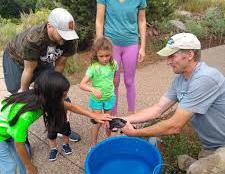
With an eco-friendly focus and a curated and eclectic lineup, Pure Imagination is Arizona’s most unique music festival, marrying soundscape and landscape while leaving limited impact on the gorgeous topography of the region and Prescott’s remarkable Watson Lake. Don’t miss this year’s event when Pure Imagination returns Friday, May 17 and Saturday, May 18, bringing a wide diversity of sound and culture to a picturesque, inspiring outdoor setting.
Tucson Art Walk
Wilde Meyer Gallery Tucson will be highlighting a stunning group of artists throughout the month of May. On the May 2 ArtWalk, there will be live music by harpist Vanessa Myers, great art, and light refreshments from 4 - 7 p.m. Wilde Meyer Gallery, 2890 E. Skyline Dr, Suite 170 in Tucson.

Mt. Lemmon Hill Climb
In celebration of Tucson’s singular cycling challenge, Greater Arizona Bicycling Association (GABA) sponsors the Mt. Lemmon Hill Climb. The route of 59.6 miles starts at McDonald District Park on Harrison Road, north of the Santa Catalina Hwy. Although the road is long, it's also very forgiving — the grade averages only 4.5% over the 6600 feet of elevation gain in a 56-mile round trip, and the almost continuous 21-mile descent at the end is exciting without ever being terrifying. This event will include a “staged release” with no more than five riders starting at a time, so everyone will feel comfortable.
Historically, the Tucson 5000 is one of the fastest 5Ks in the West. This pancake flat, fast USATF-certified course provides the perfect opportunity for a 5K pro or for your first 5K on a course that is beginner-friendly. This race has been a Tucson staple for over 20 years. The FitKidz Mile will be a flat out-and-back course, providing a great opportunity to cheer your kids on twice! Presented by Southern Arizona Roadrunners. Reid Park, 900 S. Randolf Way, near the corner of 22nd and Country Club in Tucson.
C“Closeness to wild living things, trees, grasslands, birds and animals, nurtures in those who live in the spacious lands a sense of wonder, a sensitivity to beauty, a reverence for life and creation.” Charlie Orme, 1962
Spring is bursting forth on The Orme School Campus. Our edible campus is full of fruit blossoms and perennials breaking their dormancy and waking up to life once more. As the Say’s Phoebe perches in the morning sun on the branch of a flowering plum tree in the Burpee Orchard, a bridled titmouse flits among the fruit and seeds of the Hackberry trees.
Once you are “up on top” - the area that sits above the main campus and ranch pond - you can see the ridges of the Bradshaw mountains and what we call “Big Mesa.” The landscape is vast. A golden eagle sits on a rock outcropping above the grazing lands, surveying the semi-desert grasslands below, waiting for air warmed by the sun to lift it above.
Graduation will be here before we know it and soon after, the Southwest willow flycatcher and Western yellow-billed cuckoo will return to their nesting territory on the edges of campus, in the riparian area along Ash Creek. Their familiar sounds will echo through the Burpee Garden Complex all summer long. Summer campers will return to help harvest fruits from the orchard and grapes from the vineyard.
The Orme School is unique in that it has a long standing tradition of outdoor, place-based education on a working ranch with a strong land ethic. Today, we serve a strong and diverse
domestic and international student body, but, from the beginning, the Orme family emphasized relationships with the plants, birds and other animals with which they share this land. This was instilled in the students they started instructing in 1929. The Orme School becomes home, and family, for many students, as we are a college preparatory boarding school for students in grades 8-12. Stanley Knowlton, a student from 1934-1937, said, “The Orme Ranch was my real home.”
Billy Cordasco (Orme, 1980) is a fine example of the influence an education at The Orme School can have on a student. He is now President of Babbitt Ranches, managing over 700,000 acres in Northern Arizona. Babbitt Ranches has executed one of the largest conservation easements in the country, developed wildlife conservation projects for species such as the blackfooted ferret and the golden eagle, and has diversified in other endeavors including renewable energy.

Still today, amid new challenges, The Orme School teaches this relationship and responsibility to the Earth. The Orme family leads by example and recently entered over 900 acres of private deeded land adjacent to campus into a conservation easement with the Central Arizona Land Trust. Our science department
received a grant for the 23-24 school year from the Arizona Game and Fish Department’s K-12 Heritage Program to expand our wildlife education initiatives, including the purchase of a classroom set of binoculars for students’ regular use. Our students participate in Environmental Day at the Arizona State Legislature. The Burpee Garden Complex not only provides educational opportunities for students but also community outreach and education such as an annual fruit tree pruning workshop and garden educator tours, as well as providing fresh food to our dining services and our local food pantry. The chores program that has always existed at the school, continues as every student helps around the campus and ranch in gardening, horsemanship and general maintenance. Parents of current students are welcome to participate in a community action day in the fall and an Earth Day celebration in the spring.
Other current initiatives include integrating sustainability throughout our curriculum, activities and special events and developing more project based learning. To help meet this goal, all of our faculty are familiar with and utilize the Six Key Competencies in Sustainability (Wiek, Keeler & Redman, 2011). Arizona State University describes these competencies as “complexes of knowledge, skills, and attitudes that enable successful task performance and problem solving related to real-world sustainability problems, challenges, and opportunities.”
The Key Competencies in Sustainability are:
• Systems Thinking
• Futures Thinking
• Values Thinking
• Strategic Thinking
• Interpersonal Competence
• Integrated Problem-Solving
Competency in each of these areas complements basic academic success such as development of effective writing skills and ability to interpret tables and graphs. The result is an individual who is resilient, loves learning, and who is able to comprehend and solve problems on interdisciplinary teams. This is the kind of problem solver the world needs now. This is the type of student The Orme School strives to graduate. These are the messages of today speaking to us from long ago through the values and beliefs the Orme family established for this school from the beginning.

“Let the qualities that characterize [people] who live near the Earth, their resourcefulness, versatility, adaptability, elasticity, democratic attitudes and enthusiasm combine with the discipline, appreciation of cultural values, and respect for the good in history and tradition - those values to be the most often derived from the scholarly world - and re-energize the new [person].” Charles Orme, 1962


Courtesy Automotive Group has an impressive selection of electric vehicles (EVs)! With an emphasis on cuttingedge technology and eco-friendly design, our EV selection showcases the latest advancements in automotive innovation. Courtesy specializes in EVs by Chevrolet, Nissan, Polestar, Jeep, Kia and Volvo. From sleek sedans to versatile SUVs, each vehicle offers not only zero-emission driving but also top-tier performance and advanced safety features.
Whether you’re a seasoned EV enthusiast or considering your first electric ride, Courtesy Automotive Group is dedicated to helping you find the perfect vehicle to fit your lifestyle!









